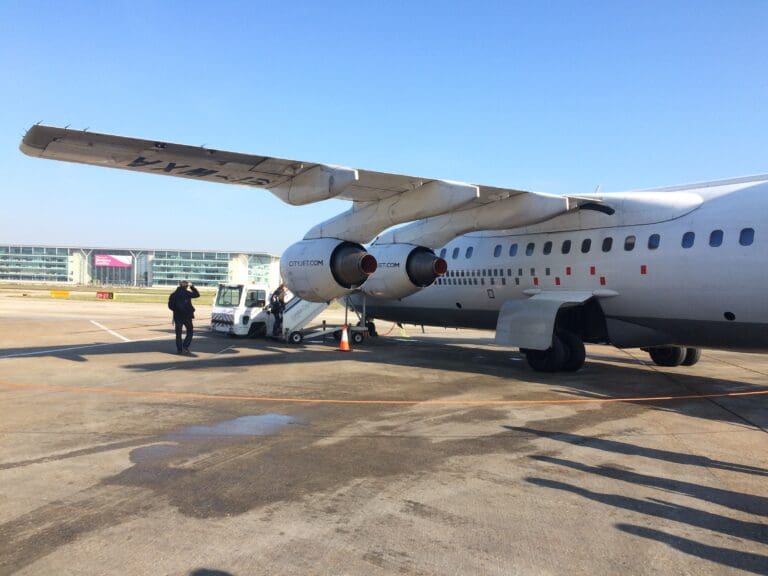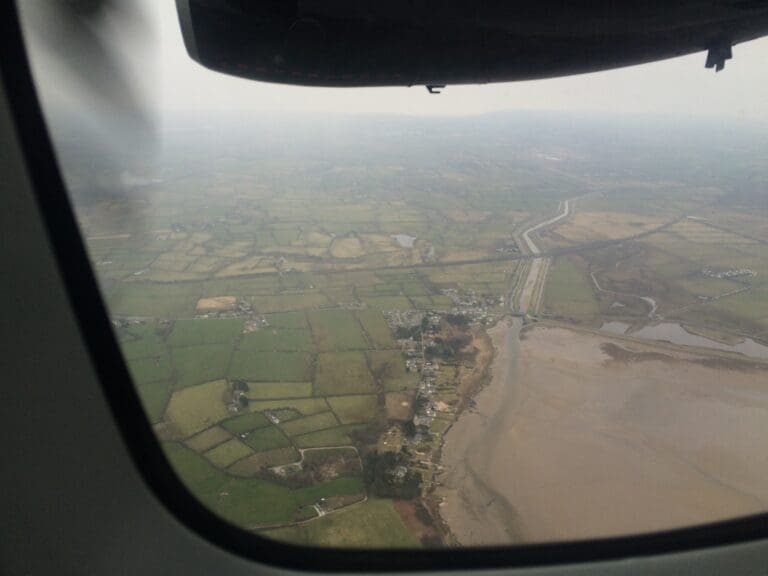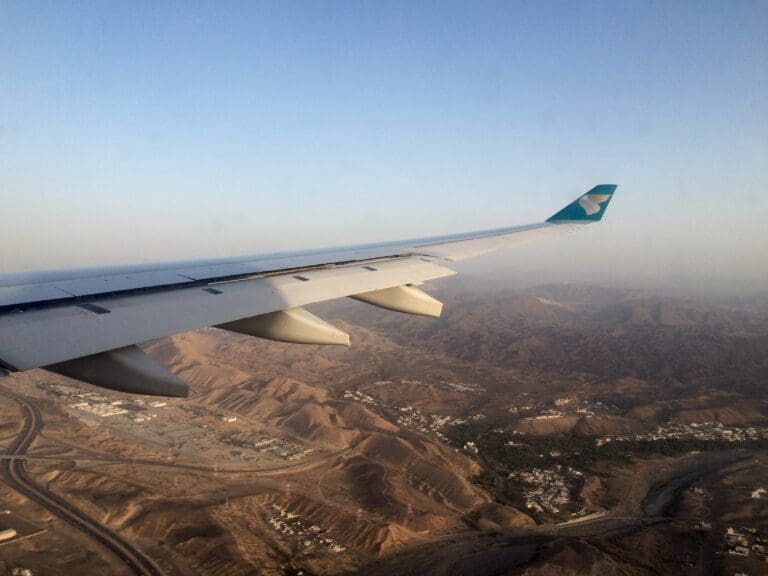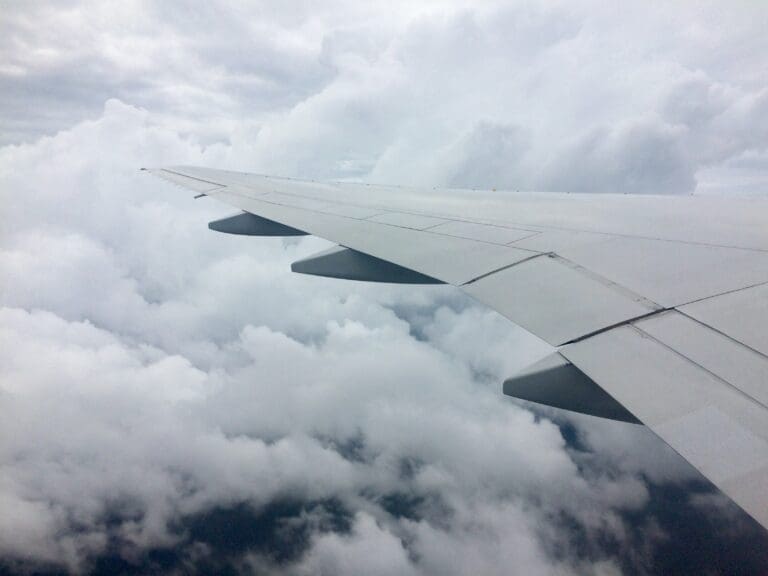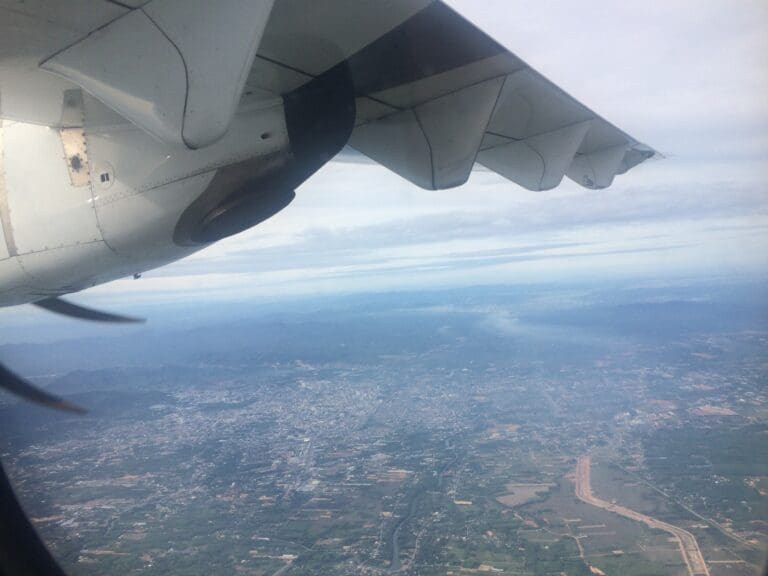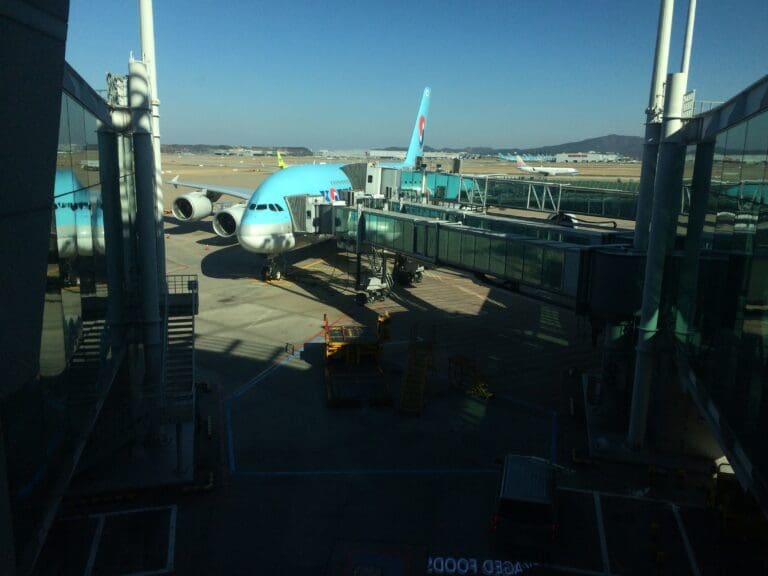Remembering Flybe 1.0: Birmingham to Bordeaux on a Dash 8 Q400
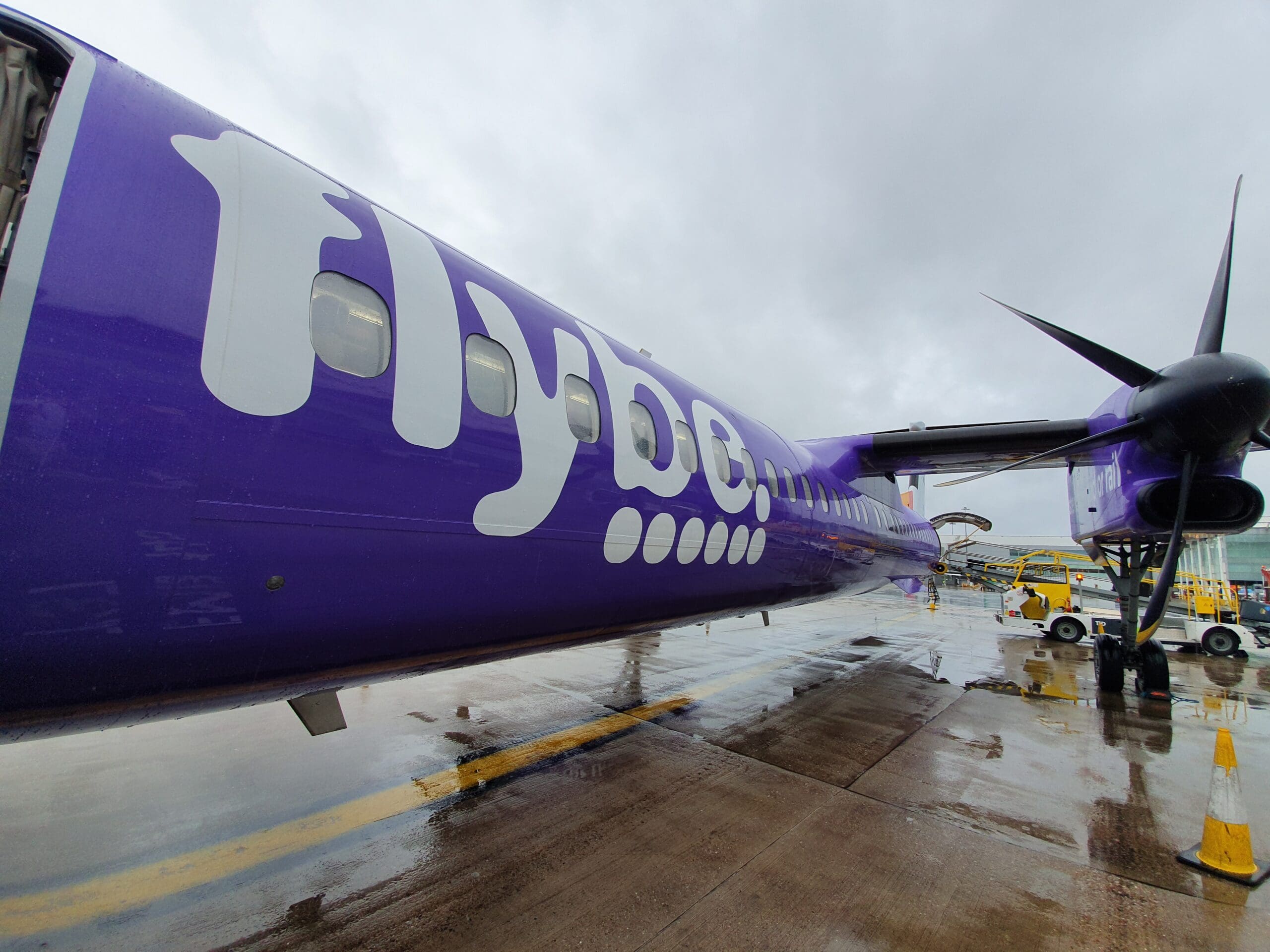
Introduction
In March 2020, the first incarnation of Flybe operated its final service. Having become well known for its financial woes during its final few years, the pandemic sounded the death knell for the first incarnation of Britain’s long-standing regional carrier.
Whilst the Flybe brand had been around for eighteen years at this point, the carrier’s roots date back to 1979 when Intra Airways and Express Air Service merged to form Jersey European Airways. As its name would suggest, this carrier focused on connecting Jersey to airports across the UK, initially with a fleet of venerable Douglas DC-3 aircraft. In 1983, Jack Walker’s Walker Steel Group acquired the carrier and its operational hub and headquarters were shifted to Exeter Airport, whilst the focus of operations remained on the Channel Islands. Expanding throughout the 1980s, Jersey European Airways came to adopt a smorgasbord of eclectic types, including the Britten-Norman Islander, Embraer 110 Bandeirante, Fokker F27 Friendship, Short 330, Short 360 and Vickers Viscount. By the end of the decade, Jersey European Airways served Belfast, Birmingham, Blackpool, Bournemouth, Guernsey, the Isle of Man, Jersey, Manchester and Teeside, alongside two French destinations – Dinard and Paris CDG. This expansion continued throughout the 1990s, encompassing more British regional airports and destinations abroad, such as Amsterdam, Lyon and Toulouse.
By the new millennium, Jersey European Airways’ operating model had transformed, with the airline’s focus now arguably just as focused on connecting British regional airports with destinations across the country and Western Europe as it was on connecting Jersey. Thus, the airline rebranded as British European Airways and procured new aircraft types, such as the BAe 146, Bombardier CRJ-200, Dash 8 Q200, Dash 8 Q300 and Dash 8 Q400, all of which joined the carrier’s fleet in 2002 resulting in what must have been a rather chaotic year of change! Adding to this, in July 2002, the airline rebranded once again, this time settling on Flybe.
By the early 2000s, Europe’s low cost boom was in full swing, and following this model, Flybe transitioned away from being a business traveller-orientated airline to a low cost carrier. Domestically, the airline aimed to rival long-distance train passengers and, in some cases, undercut fares for such journeys. Whilst internationally, the airline sought to provide a rival to full-service carriers and boost international connectivity from Britain’s regional airports. In terms of its fleet, in 2005, the decision was made to simplify this, retiring all types bar the Dash 8 Q400, and procuring 26 Embraer 195 regional jets, the first of which was delivered in 2006. Meanwhile, the carrier was able to take advantage of its routes to major Western European hubs and launched codeshare agreements with an array of carriers from across the world, from Cathay Pacific and United Airlines to Pakistan International Airlines! Further expanding its operations, in November 2006, Flybe acquired British Airways’ regional subsidiary, BA Connect, and took over Loganair’s franchise from British Airways in 2008. Several years later in 2011, Flybe purchased Fincomm Airlines in cooperation with Finnair, operating services from Helsinki as Flybe Nordic. Back in the British Isles, in 2014 Flybe entered into a multi-year agreement with Stobart Air which would see the Irish carrier operate services from Southend and the Isle of Man on behalf of Flybe, followed by a full franchise agreement with Blue Islands and a partial franchise agreement with Eastern Airways.
At first glance, Flybe’s growth and presence across Europe may seem impressive. However, financially, Flybe came to struggle, and from 2010, a plethora of reasons saw the airline suffer a loss each year. In January 2019, Flybe was purchased by Connect Airways, a consortium that included Stobart Air and Virgin Atlantic, with the brand set to become Virgin Connect in 2020. However, plans failed to make it that far, and in March 2020, the airline entered administration.
Background and Booking
Alongside Dublin, Paris is perhaps the most easily reached European capital from just about anywhere in Britain. Aside from the frequent Eurostar services that run from London St Pancras and allow passengers to be in the City of Light in a little over two hours, almost every regional international airport throughout the UK offers services to one of Paris’ airports. Finding myself at my parent’s house in my hometown of Sheffield during the two weeks between moving away from London and moving to Paris, both flying and taking the train seemed viable. Direct services from Sheffield to London St Pancras run every half hour and take a little under two hours. Meanwhile, a plethora of services are offered from all those airports that surround the city, including, at that time, the city’s airport, Doncaster Sheffield. However, it should be noted that Manchester Airport is just as convenient to reach, if not more so than Doncaster Sheffield! Yet, holding the stereotypically tight budget of a recent graduate, I could not be picky and instead had to opt for the cheapest option. As it happened, the cheapest flights departed from Birmingham Airport. Surprisingly, these were not offered by any budget airline, but rather by full-service flag carrier Air France.
Seeing as my required departure day fell within the midst of the summer holiday rush in late July, it came as little surprise to see that all five direct options offered by Air France’s website (only one of which was operated by Air France) came with the extortionate price tag of £225 without luggage. I thus scrolled passed these and examined the long list of connection options, these consisting of expensive KLM combinations via Amsterdam and far more reasonably priced slightly indirect options via Bordeaux. Turning to the latter combination of flights, these were priced at £92, or £118 for a ticket that included 23kg of hold luggage. This consisted of a 0845 departure on Flybe’s Dash 8 Q400 service down to Bordeaux, connecting onto either an Air France Airbus A320 to Paris CDG or a Hop! CRJ-1000 service to Paris Orly. Immediately drawn to the latter as this was both an airline and a type (and a relatively rare one at that) that I had yet to sample, I was in luck to find that this also happened to be the option with the shortest connection time, a wait of a little over three hours in Bordeaux. As it happened, Bordeaux Airport is one I am rather familiar with and thus, whilst pleasant, I was aware that I would most likely run out of things to do during my stay!
Using Air France’s app, once I selected this combination, in the usual manner I entered my details and attempted to enter my Korean Air Skypass number. Apparently, this was too long and thus I was unable to enter this – not that this was a problem seeing as the mileage from this journey would end up being minimal and I could always enter this number at a later date or use Korean Air’s convenient missing miles tool. After declining travel insurance (I already hold this), I entered my payment details, and without any glitch, this was processed and I was presented with a loading screen. Expecting to be presented with my ticket, after a couple of minutes I was instead handed an error message. Taking logical steps, I checked my banking app which confirmed that £117.89 had successfully been taken from my account, yet lost somewhere in the cloudy skies, I had been left grounded without a ticket. From there I searched for the flights, finding that my original selection had vanished and the cheapest tickets now stood at an extortionate £225. Wasting no time I called Air France UK’s call centre, and, after a five-minute wait and five-minute conversation, as I had suspected the airline too was unable to find my booking. Instead, I was given an email address and advised to give all the details regarding my non-existent purchase.
Five hours after this debacle, I received an email with my initial itinerary complete with a booking reference requesting that I pay for the flights. The price was only locked at £117.89 until 1600 that day (bear in mind that it was now 2015). Ignoring the payment command, I entered the booking reference into the app along with my surname. All went well, and I was given all the details related to my booking.
My next task involved making arrangements to reach Birmingham Airport in time for my 0845 departure. During the day, those travelling from Sheffield to Birmingham Airport will face little difficulty in doing so via public transport. The airport’s dedicated station is easily reached in a little over an hour and a half, the only potential complication arriving from a short change of trains at Birmingham New Street Station. Furthermore, according to Google Maps, travelling the 65-mile journey by car will take a similar amount of time. However, unable to drive, reaching the airport via public transport was my only option. Seeing as the first rail departure from Sheffield to Birmingham on a Sunday morning did not leave Sheffield until 0855, travelling by train was very much a non-starter. Having faced a similar situation the previous summer thanks to an early morning departure to Dusseldorf, during that trip I spent the night before at the cheap yet notoriously terrible Britannia Hotel in the centre of Birmingham.
However, seeing as the day before departure was my father’s sixtieth birthday, missing his birthday evening would have been unthinkable. Left with no other viable option, I turned to the trusty National Express coach. Intercity coaches had once served as my trusty steed during my trips from London back to my hometown during my first year of university, a time when I was willing to sacrifice my comfort for four hours just to afford an extra two pricey London pints. However, travelling between Sheffield and Birmingham Airport in a total of three hours and making stops in Nottingham and Leicester, was most certainly not the most time-efficient journey, nor was it very cost-efficient. This came to a total of £23, slightly more than I would expect to pay for the train ticket between the two. With the bus ticket purchased, there was little for me to do bar enter my API data into the Air France app and prepare for my departure. A week before my flights, I received an email from Flybe informing me of their cabin luggage restrictions, with passengers allowed to take one cabin bag no larger than 55cm x 35cm x 20cm and a small personal bag, these dimensions being only somewhat less than those of Air France (55cm x 35cm x 25cm).
Online Check-In
As passengers who purchase tickets via an airline yet with their flight operated under a codeshare agreement will know, in such a situation online check-in can at times provide a few hiccups to what should be a smooth and convenient pre-flight feature. For example, having booked through KLM to travel from Minsk to Heathrow with a brief stop in Amsterdam (the first flight operated by Belavia and the second by KLM), it turned out that I could utilise neither Belavia’s nor KLM’s online check-in system. Nevertheless, I had no reason not to attempt online check-in before my departure.
After entering my details into the Air France app, I was taken to the Flybe website where I was presented with a booking summary. From there, I clicked the link which led to online check-in. Like many low-cost airlines in Europe, those who do not pay to reserve a particular seat are randomly assigned one. Thanks to the 2-2 configuration of all Flybe’s aircraft, all passengers have a 50-50 chance of getting the seat they want (assuming they want a window or an aisle seat), although if they have not been allocated the seat they want I believe passengers can pay to reserve a seat up until a short time before departure (although the last minute reserving of seats appeared non-functional for my flight).
Hoping for a window seat, I was not disappointed, ending up with Seat 10A. Meanwhile, free seat selection appeared possible for the second flight and, upon clicking upon the link to do this I was presented with the delightful sight of an entire empty aircraft, with all seats appearing to be selectable. However, despite being shown as vacant and available, clicking on these appeared to be entirely impossible, and so I returned to the main online check-in page. After this, I then proceeded to a page where I was asked to verify my passport details and continued, my check-in soon coming to a halt when I was presented with error messages informing me to check-in at the airport.
After some experimenting, I discovered that to check-in on Flybe’s website, I was required to first check-in for my Air France flight and select a seat for the second leg before returning to the Flybe site which should allow me to receive boarding passes for both flights. Opting to check in for the Hop! flight via Air France’s website seeing as I was already on my laptop, I managed to do this quickly and without any problems. Unlike the empty seat map shown on Flybe’s site, only two window seats were selectable for the hop up to Orly, these in rows 7 and 12, I decided to go for Seat 12A, a little way further forward than the seat I was hoping for. After completing this, as I had expected, my check-in with Flybe went without a glitch.
The Journey
Having been rather busy in the days leading up to my move to Paris, I had ignored packing until the very last minute, dedicating the night before my departure to this. Retrospectively, considering that I would be in the French capital for at least six months, this wasn’t the very best idea and meant that I had little option but to pass on any sleep before I made my way down to Birmingham. Once finished, I had a shower and put on a fresh set of clothes for the very long day ahead before standing on guard duty for my pre-booked taxi which was scheduled to appear at 0235. Much to my delight, this car pulled up outside as planned and I made several steps through the summer morning torrential downpour, ending up rather soaked as I lugged my suitcase into the boot before strapping myself in for the short ride to the coach station. Zooming down the quiet streets of Southwest Sheffield, before I knew it we arrived at the coach station.
Seeing as the coach station is locked up overnight, once out of the taxi I was left with no option other than to wait outside (fortunately under shelter) until the coach pulled up a few minutes behind its scheduled arrival time of 0310. Seeing as the bus was already well into its long sixteen-hour journey down the country from Glasgow to Bournemouth, this delay was not overly surprising. After the driver checked my ticket and placed my bag in the hold, I climbed aboard and, as is perhaps to be expected when boarding an overnight bus in the middle of the night, I was greeted by the sight of a half-full bus of sleeping passengers. Inside, the bus appeared to be modern and clean, with USB-A ports and plug sockets found in each seat. Meanwhile, those with National Express’ VUER app could utilise a complimentary wifi-based streaming service. Perhaps unsurprisingly given the length of some of the company’s routes, the system appeared to be relatively well stocked with films, Vice documentaries and a host of television programmes.
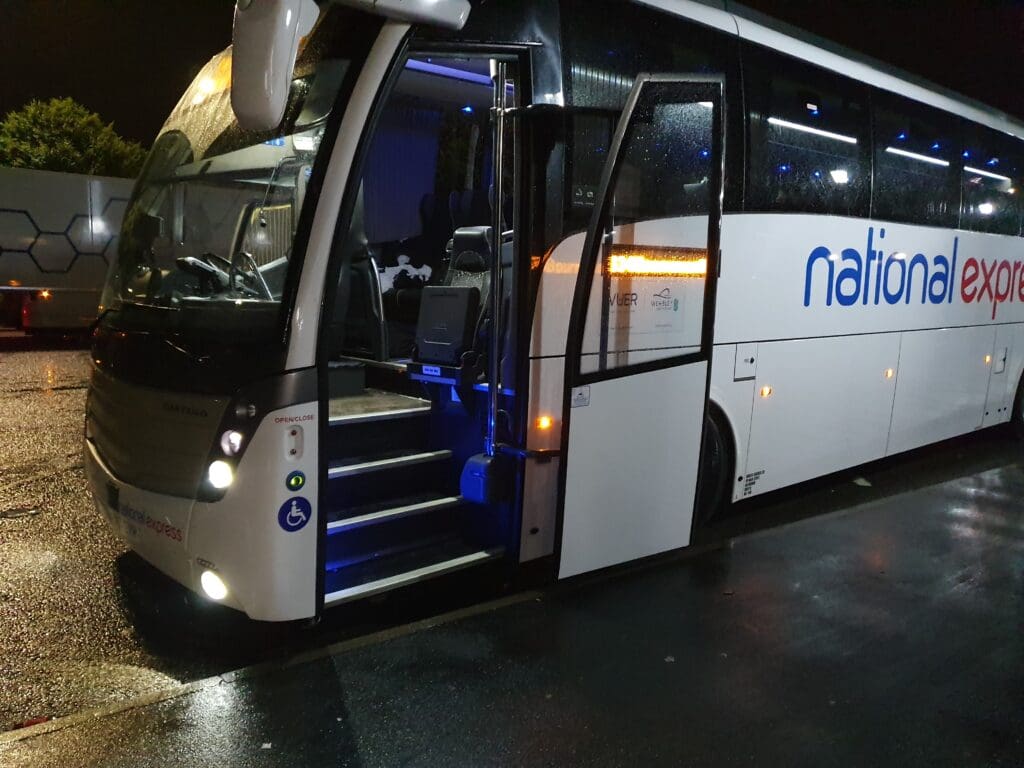
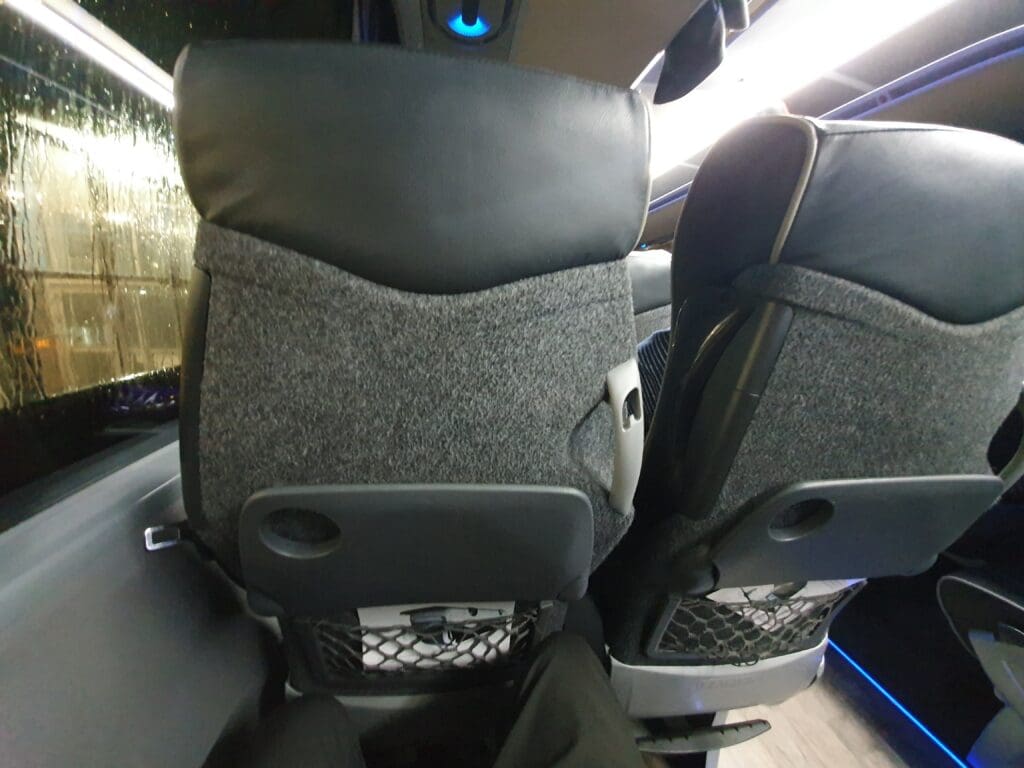
Soon, all passengers were onboard, the coach door closed and we soon began the journey southwards, crossing the border between South Yorkshire and Derbyshire heralding our entry into the Midlands. At this time, I closed my eyes and temporarily drifted off into a light sleep, however, I soon woke up thanks to the lights being turned on at full blast as the coach made a service station break near Nottingham. By 0430 the skies had begun to brighten, however, despite sitting on the East-facing side of the coach, the rainy overcast skies prevented any picturesque sunrise as the bus trundled through the Midlands. Before I knew it, the bus left the motorway and soon came to a halt outside Birmingham International Airport’s sole terminal.
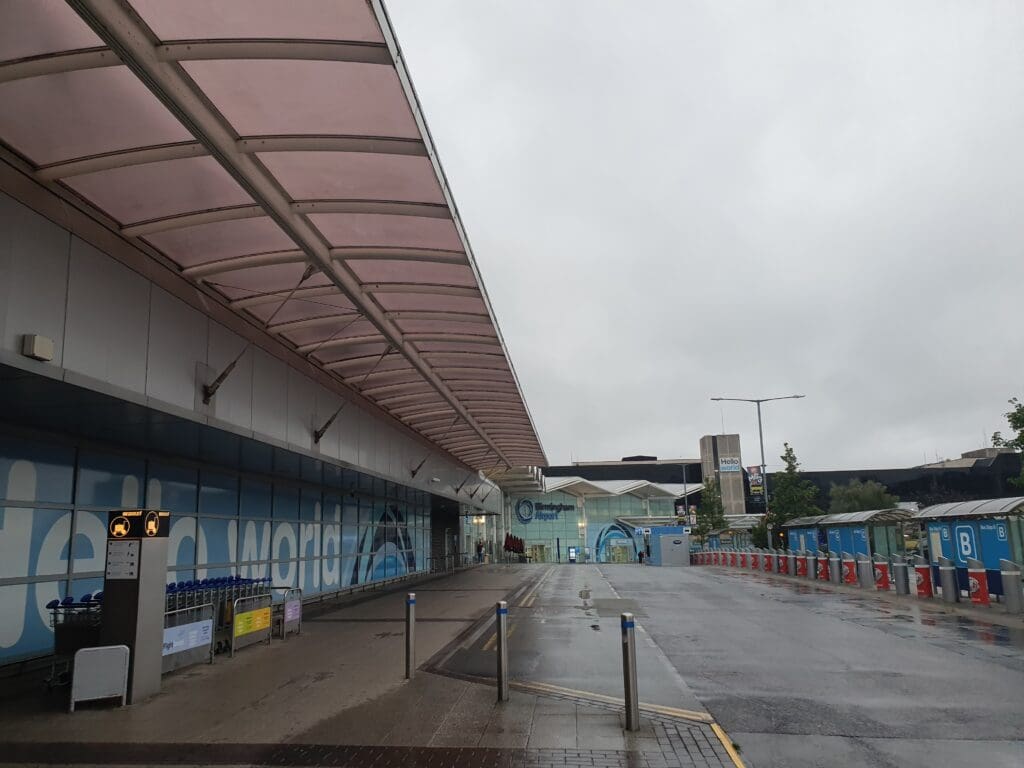
From both inside and out, Birmingham International Airport’s landside area can be concluded to be neither superbly modern nor incredibly pleasing to the eye. This consists of two check-in areas, the older and larger of the two features low ceilings that give it a somewhat cramped aura, whilst the other consists of a more modern rectangular-shaped hall with high ceilings giving it a slightly low-cost terminal feel. Today, the latter part of the terminal is used exclusively by Jet2, however back then, this was also home to Flybe’s check-in area. Thus, once inside, I made my way over to this and upon arriving there I was greeted by the sight of a long snaking queue. Whilst not the most positive sign, as I approached this it became evident that those standing there were either oblivious to the presence of or were opposed to using the four automated bag drop-off counters that could be used by Flybe’s passengers. Not wanting to stand in a queue for the next half hour and seeing no reason as to why I could not use these, I decided to first head to one of the check-in machines to print off my boarding pass before guiltily walking past the masses of waiting passengers. Following a short greeting from the staff member supervising passengers as the automated drop off machines, I plonked my suitcase down on the self-check-in belt and began the easy check-in process. Well, it would have been, were my bag not 0.4kg over the 23kg limit. This is perhaps where a traditional check-in comes into its element – whilst a friendly check-in agent may have let me off for this, the machine did not and so I was advised by the staff member to do some last-minute reshuffling. After transferring some books to my backpack, I managed to get this down, inadvertently by an entire kilogram! Once the label was printed off, I attached this to the handle of my suitcase before this was sucked into the depths of Birmingham Airport.
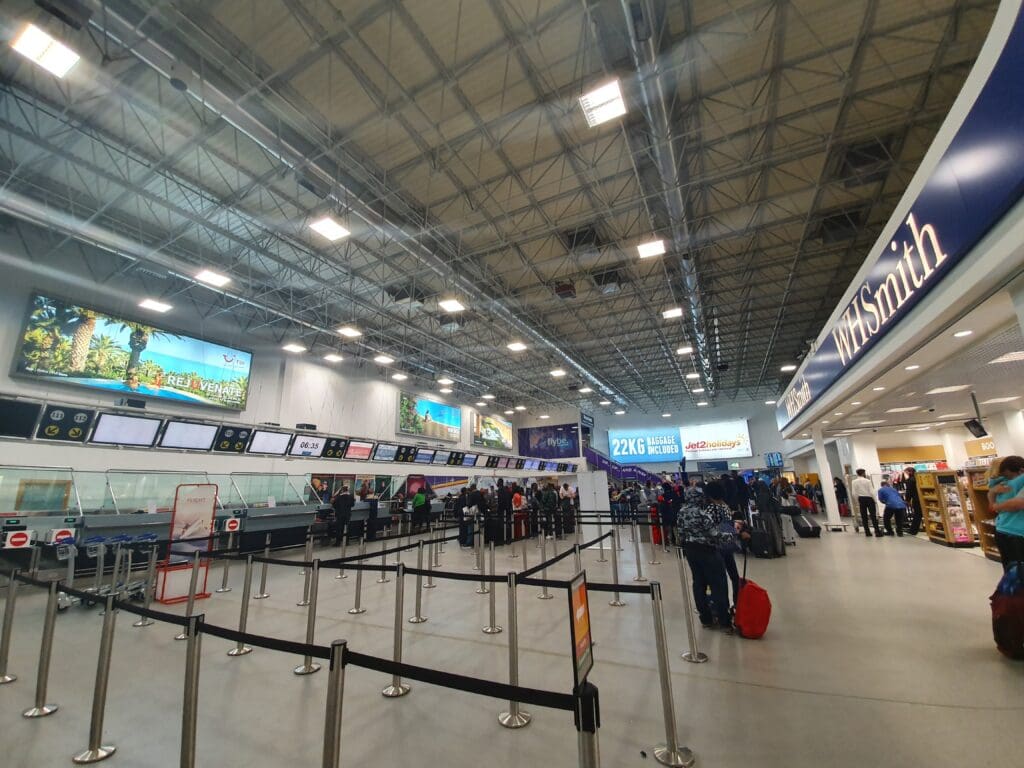
One major benefit of this newer check-in hall is that it enjoys its own entrance to the security area which allows passengers to bypass the airport’s infamously long security queues. Once I had made it to the top of the escalators, I scanned my boarding pass and joined the short queue of Flybe passengers waiting to pass through the security check. There, most staff members appeared to be relatively friendly, making light-hearted conversation with passengers, most of whom appeared to be heading off on their summer holidays. Thankfully, the staff members were also efficient, and no more than five minutes after entering security I found myself strolling through the duty-free shop which leads to the cramped main waiting area. Fancying a coffee, my first stop that morning was the local branch of Pret a Manger where I purchased a reasonably priced coffee for a total of £2.75, which, given the lack of seating in the café, I decided to have on the move as I wandered around the terminal.

Contrasting with the cramped and eternally busy main waiting area, the terminal’s ‘new’ pier (this actually dates back to 2009) is airy, spacious and bright, plus, for aviation enthusiasts, this is probably the best place to wait as this pier allows for good views onto the apron and runway. After a while, I headed back to the crowded main area before proceeding to ‘Terminal 2’ aka the pier which hosts Gates 1-20 and is mostly utilised by Flybe and Ryanair. Having opened in 1991, this area appears to have undergone only relatively minor upgrades since its construction and thus one may easily suggest that Terminal 1 requires a refit. However, whilst a little worn-looking, this pier, just like the rest of the terminal appeared to be clean and tidy and the free wifi network worked well throughout. To summarise my experience on the ground at Birmingham Airport, whilst the airport fails to enjoy a position near the top of my favourite airports list, it is most certainly not at the bottom. My transit through the airport thankfully lacked both hiccups and major queues.
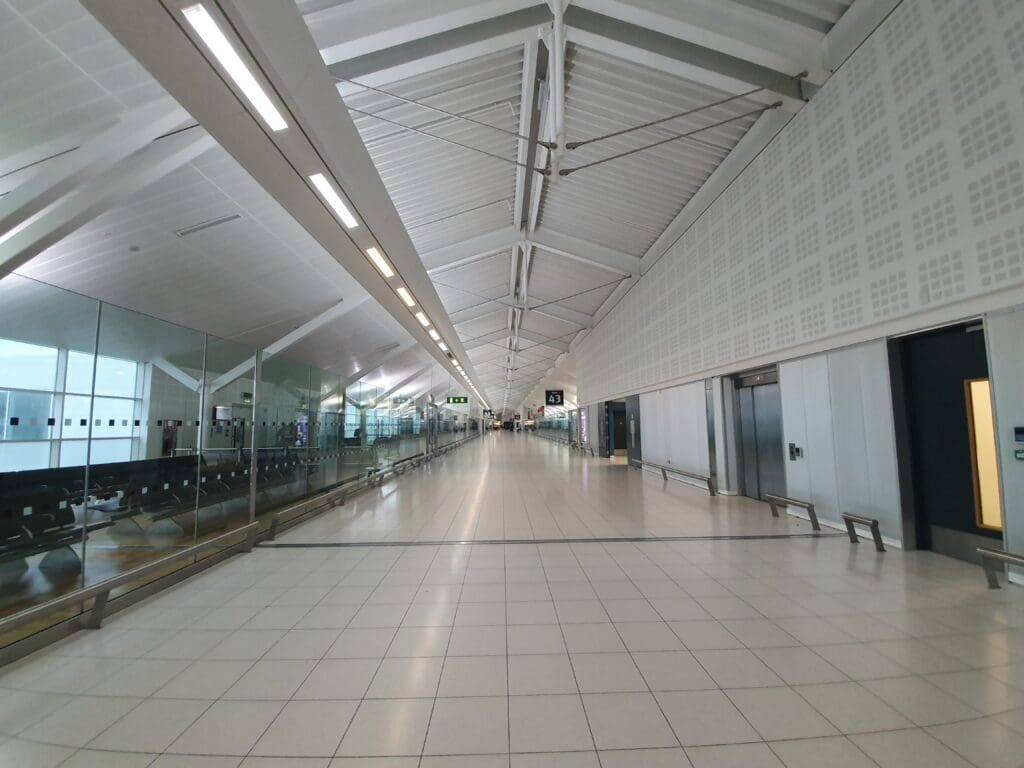
Last but not least, I could hardly fail to give some sort of mention of the movements on the rain-soaked apron below that morning. As expected the usual selection of Airbus A320 Family and Boeing 737-800 aircraft from the likes of Jet2, Thomas Cook Airlines and TUI Airways were present, preparing to jet off to sunnier climes. As is the norm in summer, the operations of these carriers were supplemented by aircraft flown by Olympus Airways and SmartLynx on these airlines’ behalf. In addition, whilst hardly a rare airframe, I was a little surprised to see a British Airways Airbus A320 on the ground that morning. As it happened, the aircraft had been heavily delayed the previous evening when flying from Pisa to London Heathrow, and, unable to land there during the curfew, this aircraft diverted into Birmingham.
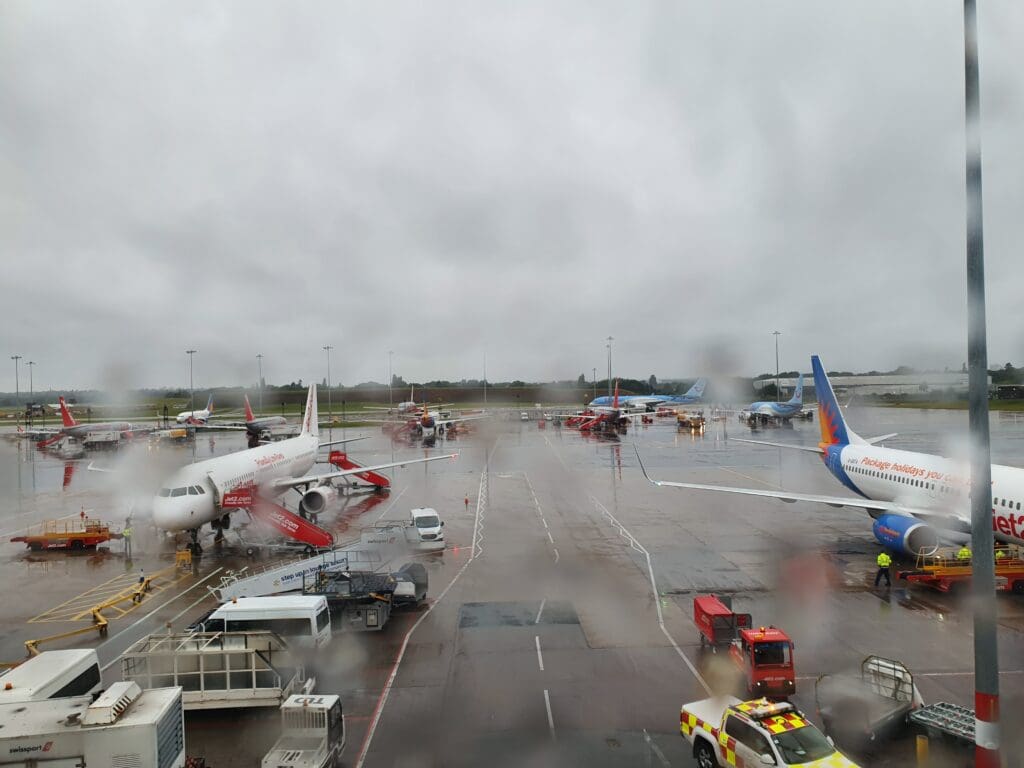
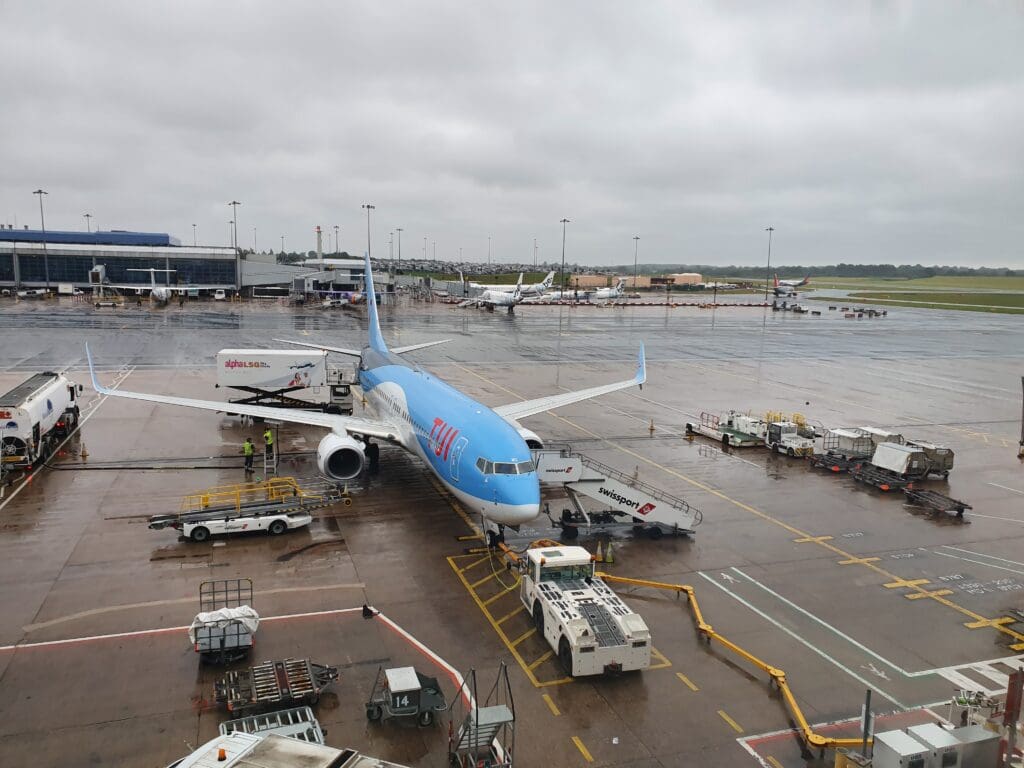
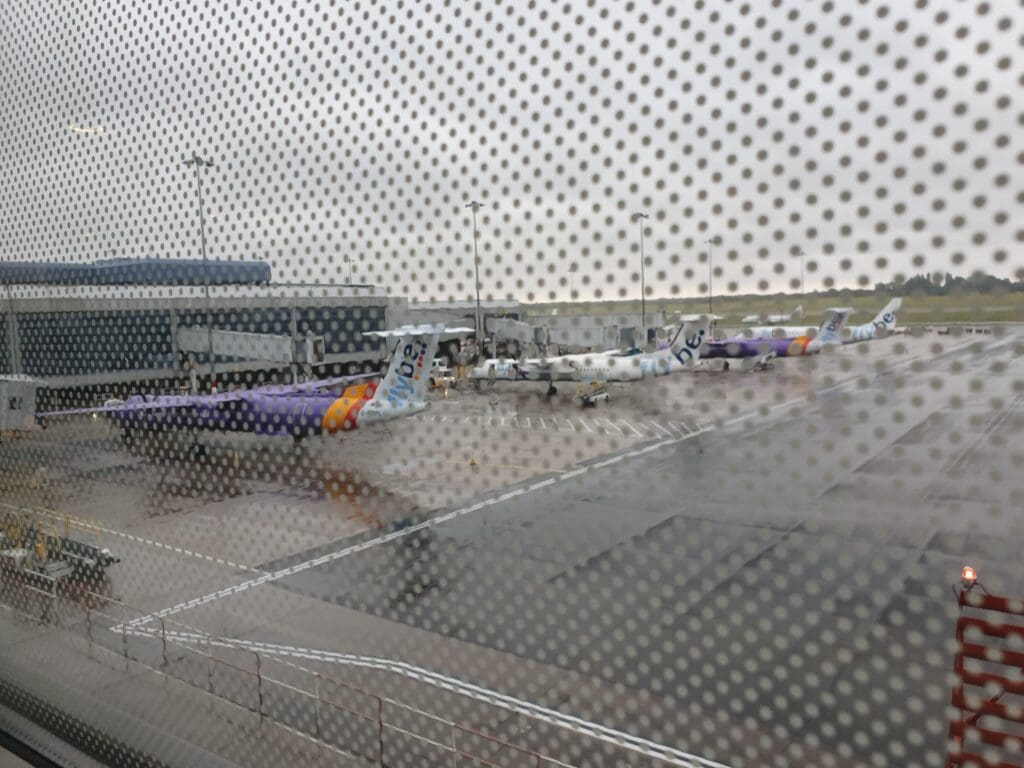
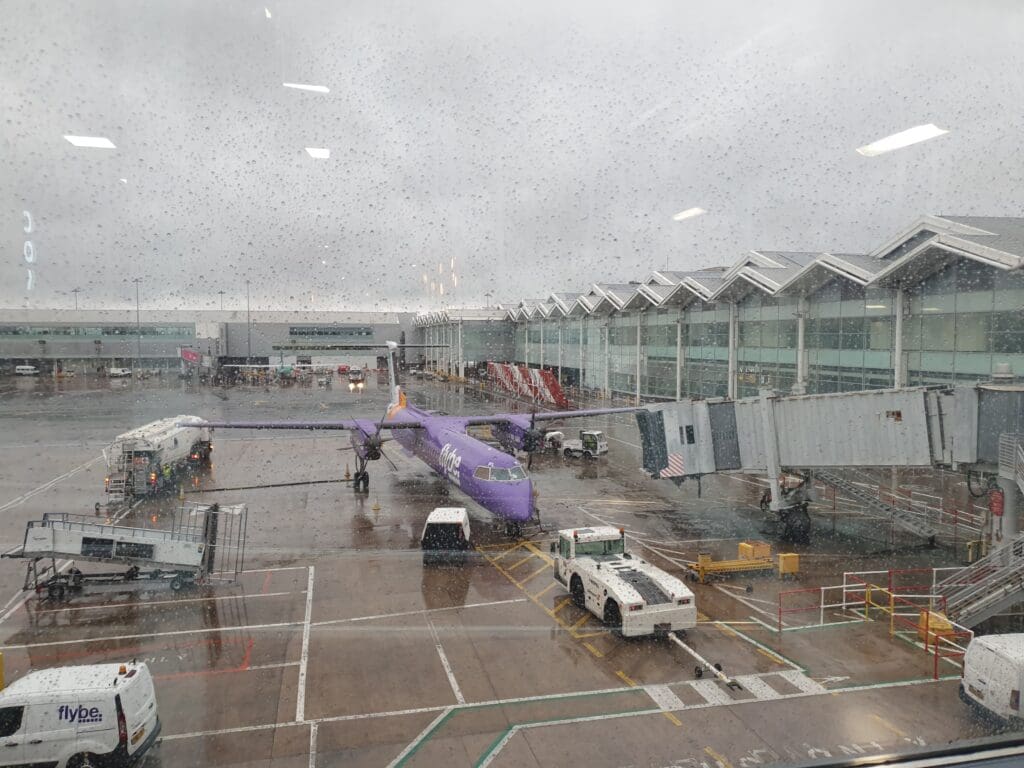
At 0818, a robotic-sounding announcement rang through the terminal in English and French claiming that boarding for the flight to Bordeaux had just commenced through Gate 16. My passion for punctuality ensured that upon hearing this, I headed straight to the gate and upon arriving there I was a little surprised to see that a long-ish queue had already formed. Two minutes after this announcement was made, the process of scanning passengers’ boarding passes commenced, although seeing as boarding was yet to commence, this was slow as the ground staff attempted to limit the flow of passengers to prevent overcrowding in the area between the podium and the doors to the apron. Therefore, I did not have my boarding pass scanned until 0830 at which point boarding had actually commenced. After this, I headed down the jetway before making my way outside and taking the stairs down onto the ramp. Unlike with some airlines, no umbrellas were provided to passengers and thus, by the time passengers climbed up the aircraft’s steps, all were absolutely soaked.
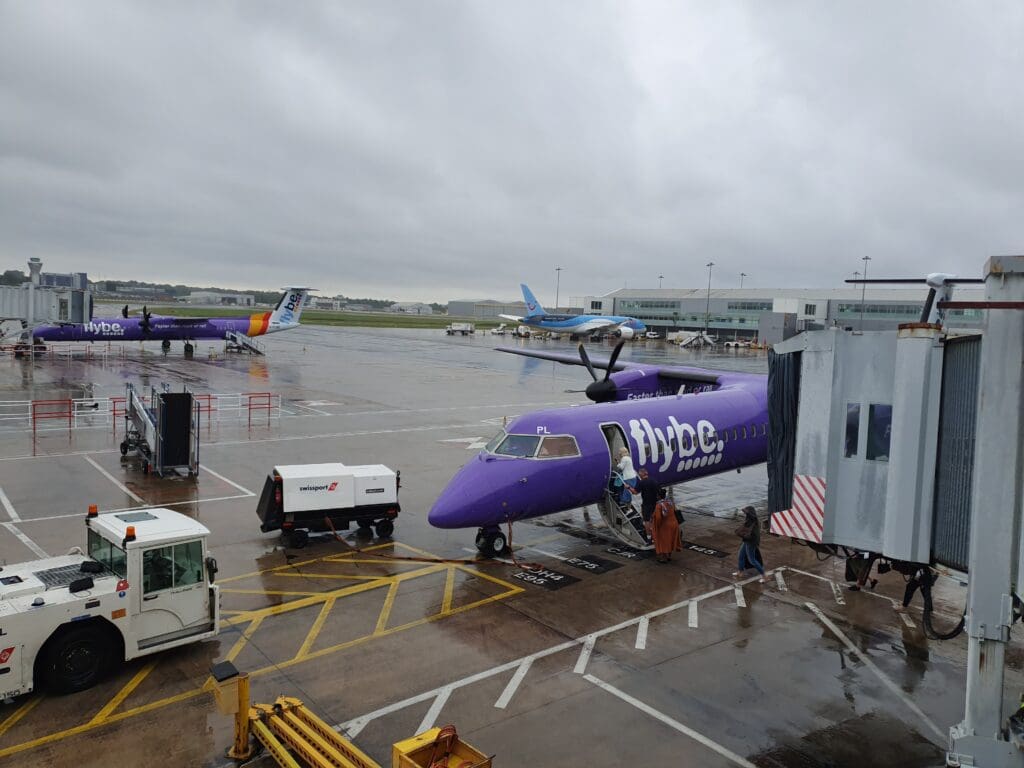
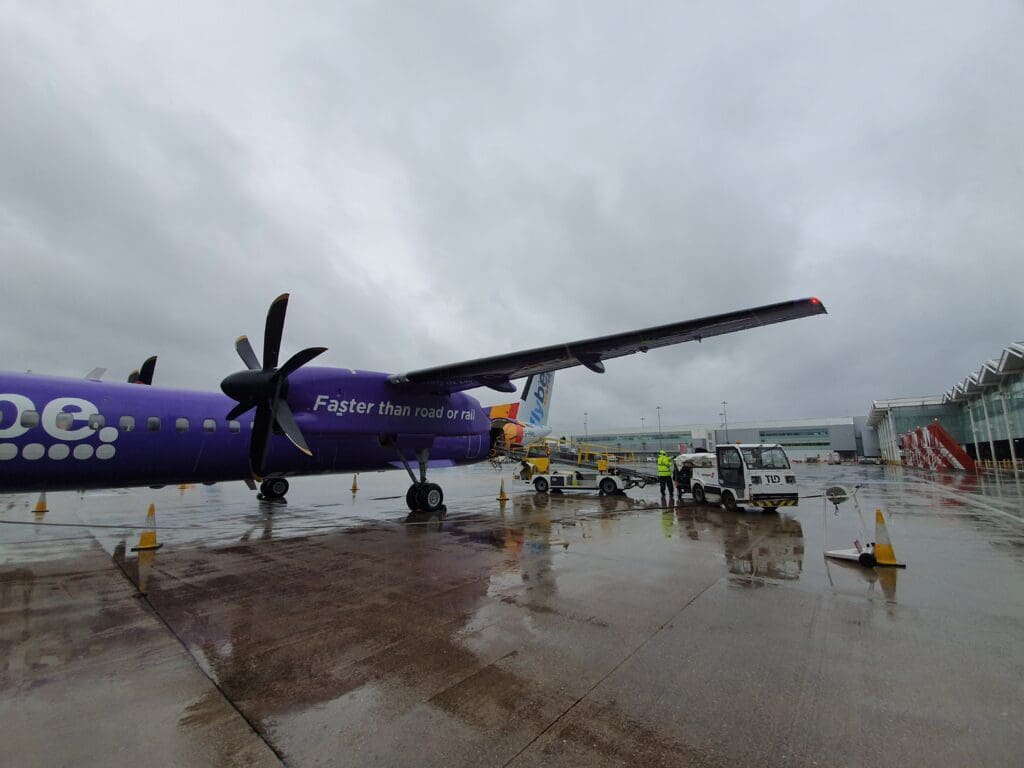
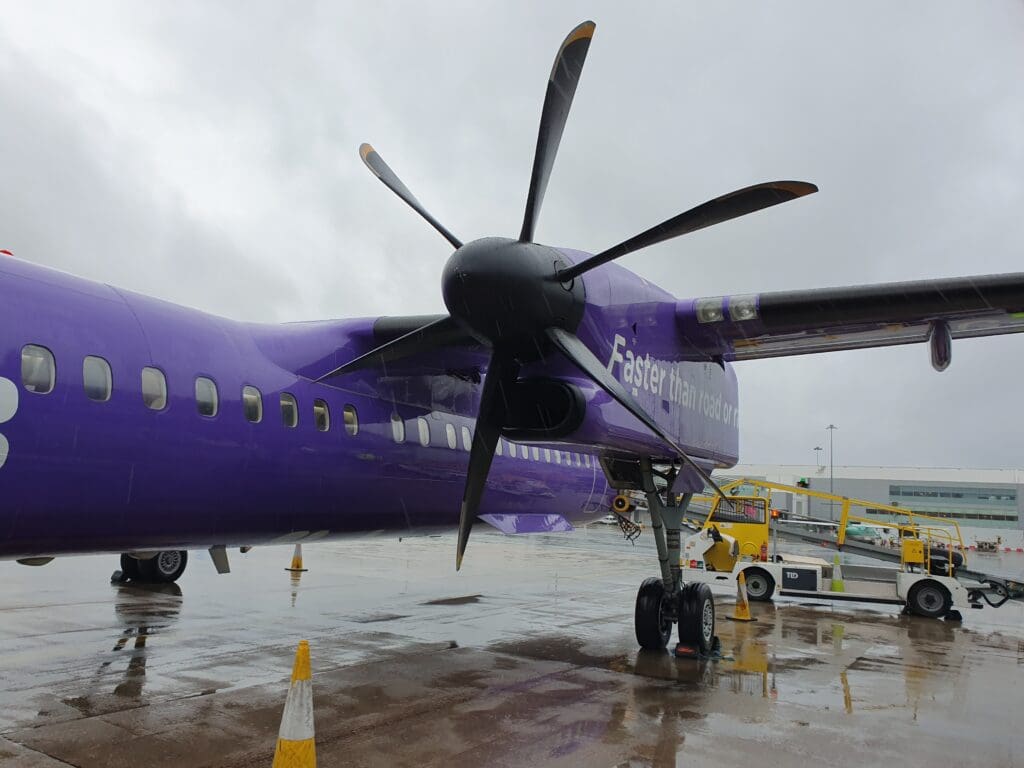
The Dash 8 Q400 that would take us down to sunny Bordeaux would be the purple-liveried, and thus appropriately registered G-PRPL. Having been built in Canada in the summer of 2011, not only was this one of Flybe’s newest Dash 8s, compared to other examples of the type flying with the airline, this airframe has a slightly more interesting history. Rather than being delivered directly to Flybe, the aircraft commenced its life in North America, operated first by Colgan Air before being transferred to Republic Airlines, both of whom flew the aircraft for United Express. In spring 2015, the aircraft was given a British registration and ferried across the Atlantic to Exeter where the aircraft was repainted and the cabin given a partial refit before the aircraft commenced its new life in Europe. According to the Aviation Herald, the aircraft experienced a single significant event in its lifetime when in February 2018 an unusual odour in the cockpit forced the aircraft to divert to Manchester on a flight between Edinburgh and London City. In the week before my flight, the airframe had flown a total of 52 flights across the UK and mainland Europe, covering at least 15,000 miles, visiting Belfast, Birmingham, Brest, East Midlands, Edinburgh, Exeter, Hannover, La Rochelle, London City, Newquay, Paris CDG and Southampton. For comparison that is similar to the distance between Birmingham and Adelaide in South Australia!
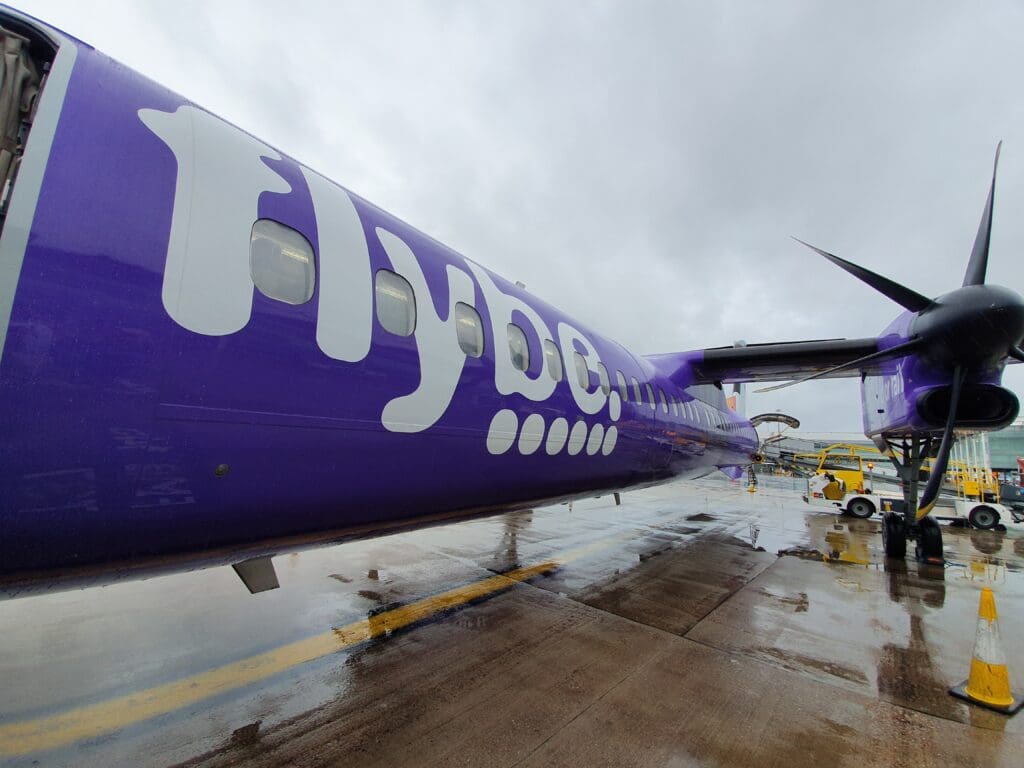
Once suitably soaked, I stepped into the cabin where I was greeted by the cheery Purser before I turned right and headed into the bright and modern cabin. Within a minute, I had made it to my seat and began to stuff my backpack into the overhead locker. Overall, my first impressions were very good. Not only had the Purser left a positive impression, the cabin appeared to be spotlessly clean, whilst the area around my seat was devoid of any marks or scratches. My positive experience continued when I sat down in one of the aircraft’s 78 grey faux leather seats. Whilst small, these were comfortable and came with an acceptable amount of legroom. Turning to the seat pocket, this contained a copy of the airline’s Flight Time magazine, a Café Flybe menu, a safety card and a plain sickbag. That morning, although the flight turned out to be around 90% full, boarding was conducted in a relatively quick manner. Focusing on the flight’s demographics, roughly half of the passengers onboard seemed to be Brits heading on holiday, whilst a quarter appeared to be from France and the remaining quarter from a selection of nations including China, Korea and the USA. At 0840, the jazzy boarding music came to an end and the non-purser member of the cabin crew (a doppelganger of Ryan Gosling) conducted a brief welcome announcement whilst the Purser closed the cabin door. Unusually, I was rather lucky and ended up with an empty seat next to me, although I did appear to be one of the very few solo passengers onboard that morning.
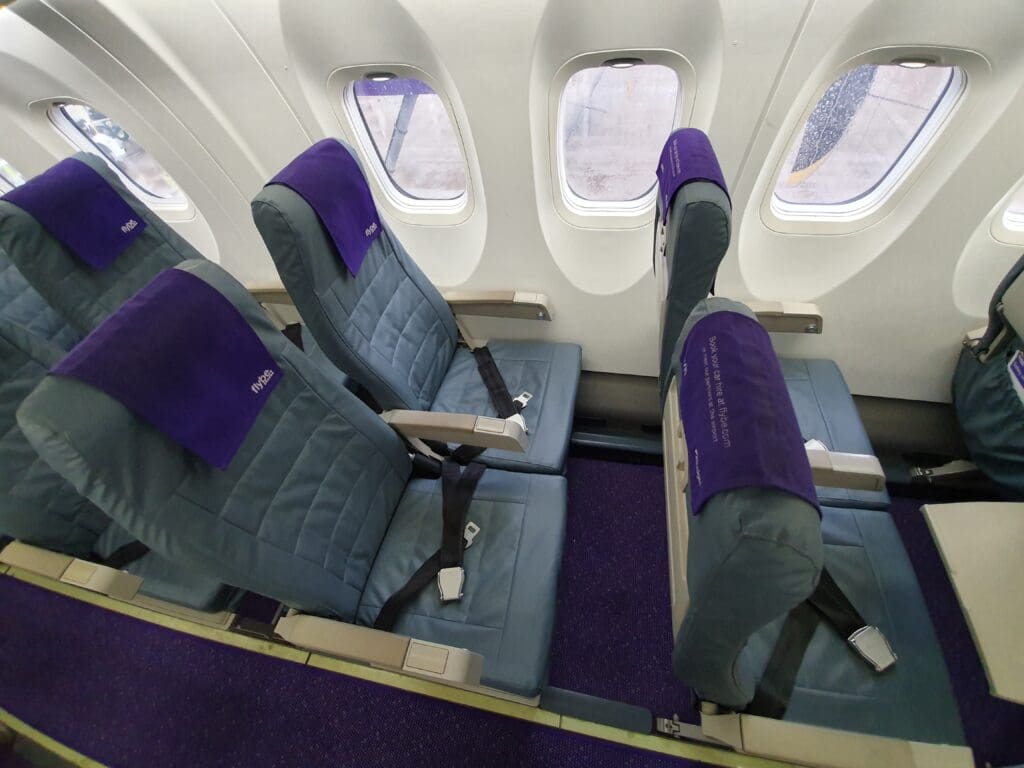

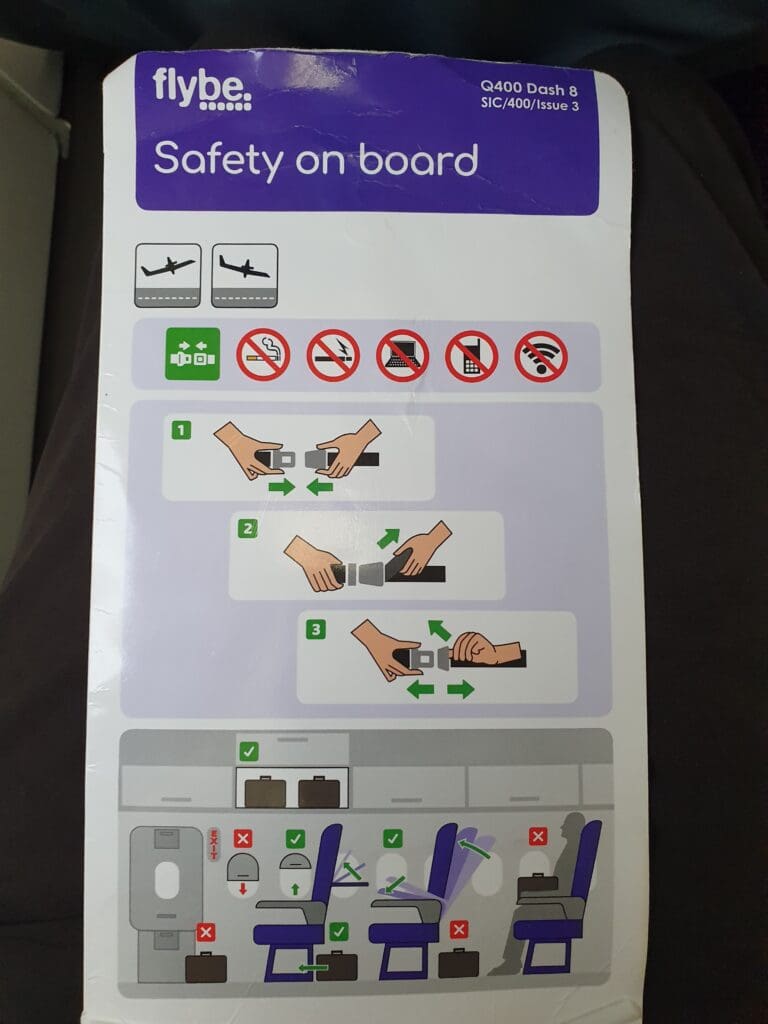
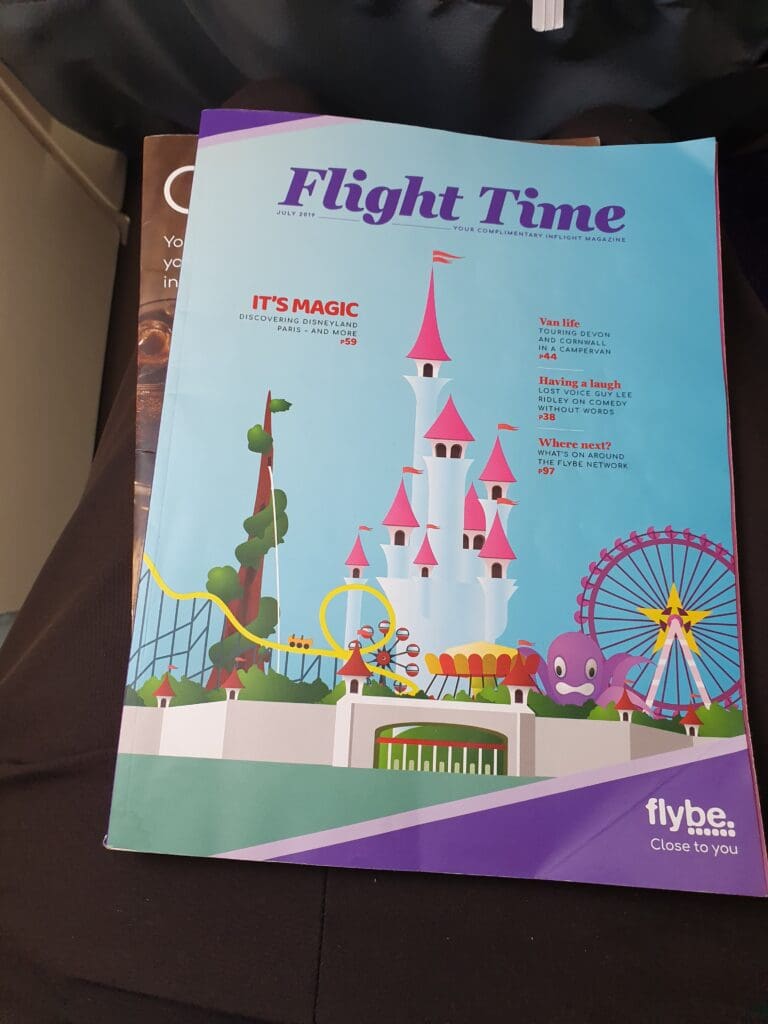
Whilst the cabin was all set for departure at 0840, the occasional noise could be heard from the rear of the aircraft as passengers’ bags continued to make their way into the rear hold. At 0845, a large clunk could be heard as the cargo hold door shut closed. One of the things that I find British airlines generally tend to do well are cockpit announcements, and that morning I was not disappointed. Once the cargo hold door was shut, the Captain gave a detailed announcement whereby he introduced each crew member, thanked us for choosing to fly with Flybe, and gave us the weather forecast both during the flight and in Bordeaux alongside a comprehensive overview of our route south. This was followed by a welcome announcement before the pre-recorded safety announcement played, with the two cabin crew members conducting a demonstration to this.
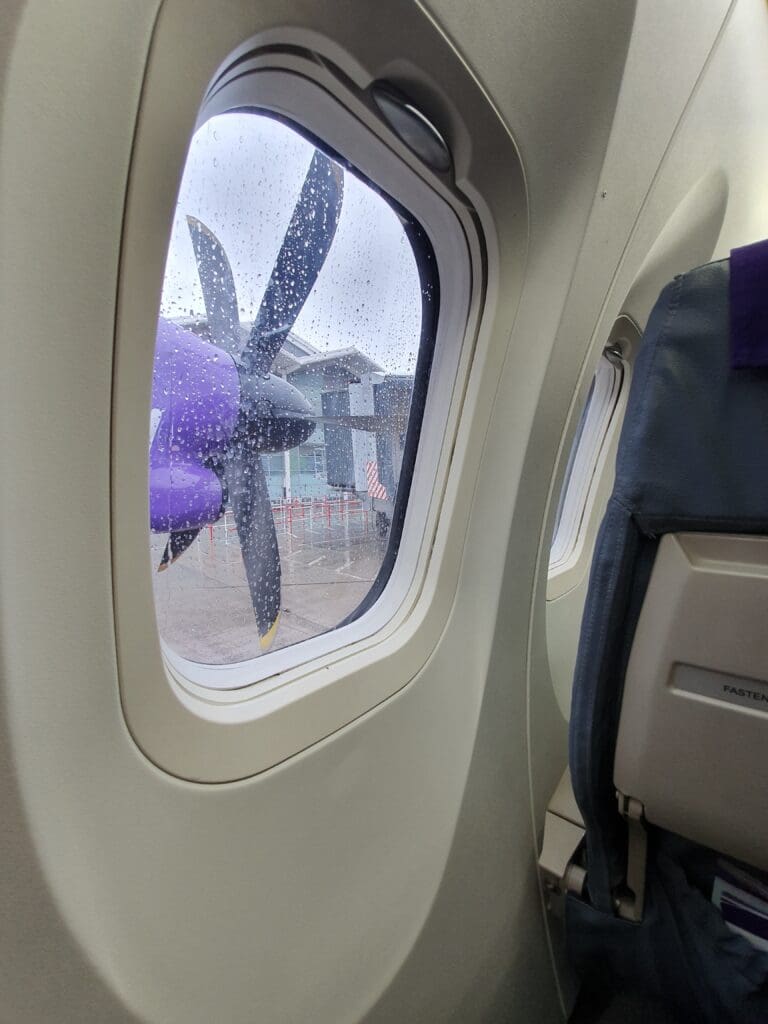
At 0850, the aircraft jolted backwards and was pushed so the tail pointed towards the terminal, then pulled forward a little before coming to a stop. After coming to a pause, the propellers of one of the two engines whirled into life, although the other was not fired up until the Dash 8 had commenced its taxi to the end of Runway 33. Seeing as my last turboprop flight had taken place on an Antonov An-24 with noisy Ivchenko AI-24 engines, the start up of the Dash 8’s two Pratt and Whitney 150A engines seemed to be rather quiet and vibration-less by comparison.
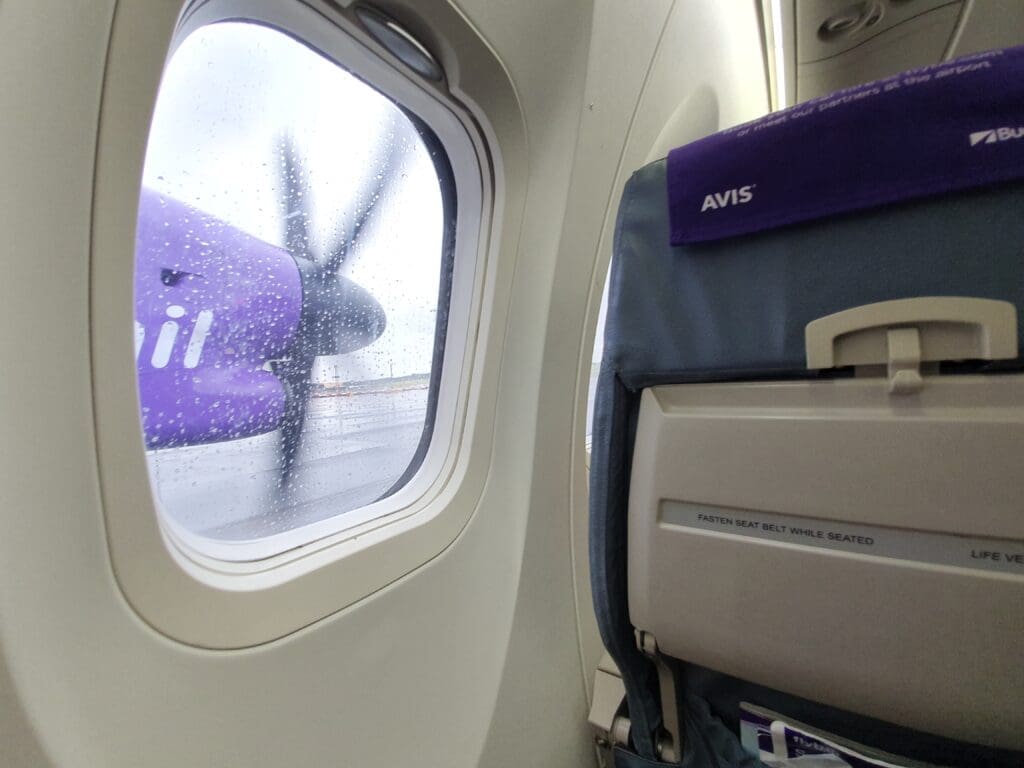
Only a little over five minutes after pushback, at 0856, the aircraft entered the runway via holding point C1 before commencing its takeoff roll no more than two minutes later. Given the reputation of the Dash 8 Q400 as a capable turboprop, it came as little surprise to find that the departure was nothing short of powerful as the Dash 8 went flying down the runway with some force before rotating upwards into the grey skies like a rocket ship. Once in the air, the landing gear was retracted as the aircraft climbed away from the airport. Unfortunately, due to the low clouds, all views of Birmingham were restricted to those of the neighbourhoods that border the airport before we made our way up into the clouds.
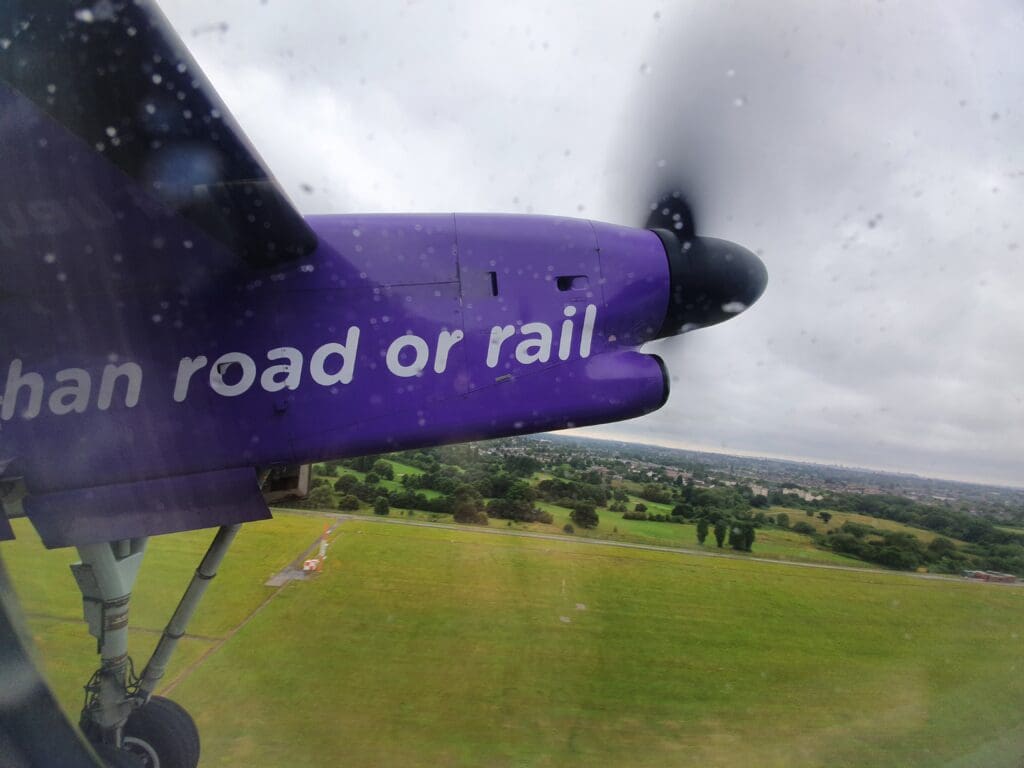
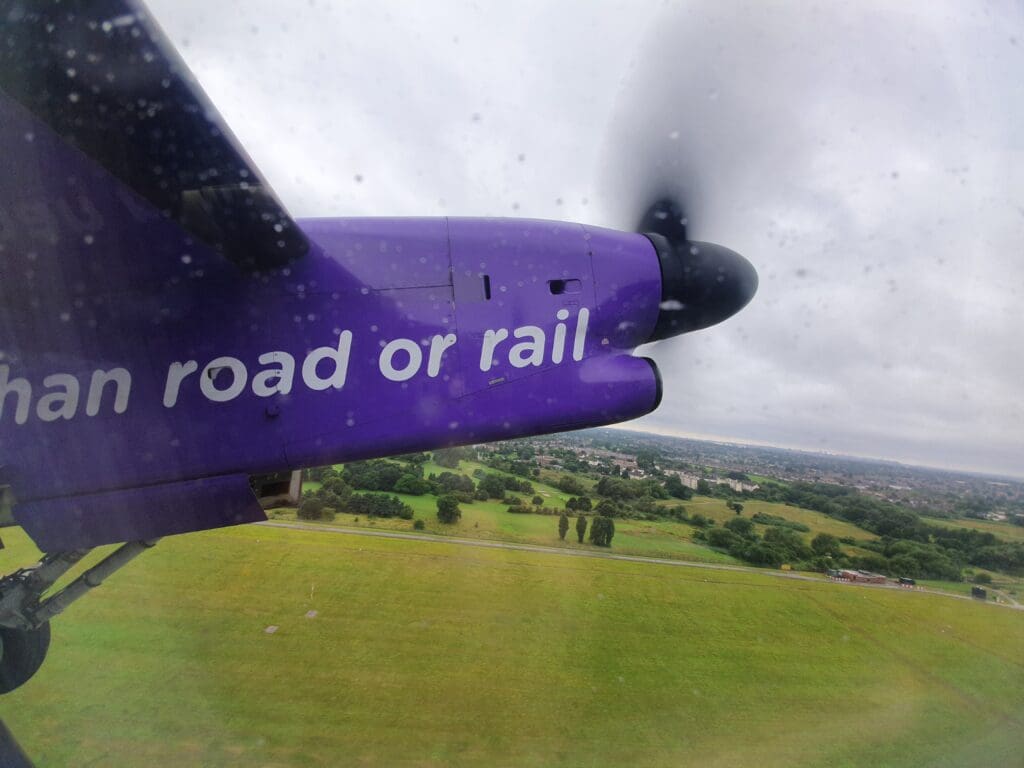
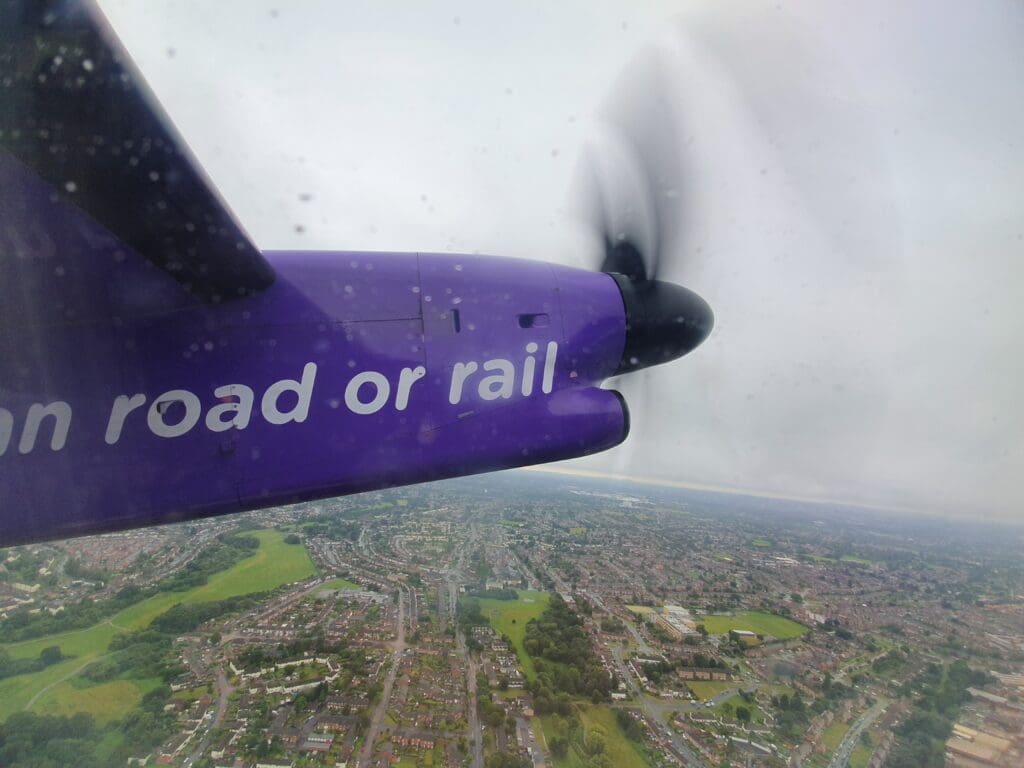
Approximately seven minutes after departure, blue skies appeared above. Moments later, the seatbelt sign was extinguished which was followed by the usual announcement advising passengers to keep these fastened when seated, also containing vital information such as the prohibition of smoking onboard and the location of the Dash 8 Q400’s sole toilet. A few moments later an announcement was made informing all of the soon-to-commence Café Flybe service, with the Purser apologising that an issue with the card machine would mean that this was a cash-only service. Not wanting to waste time, almost as soon as this announcement came to an end, the crew rolled two small trolleys to the front of the cabin and commenced this service.
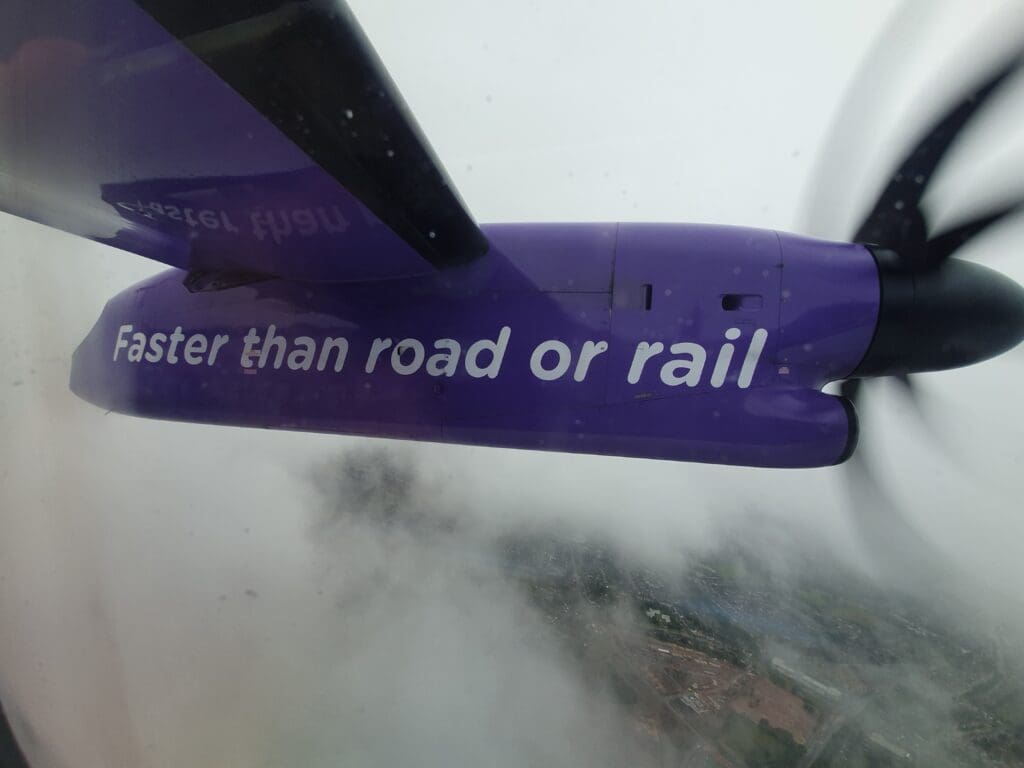
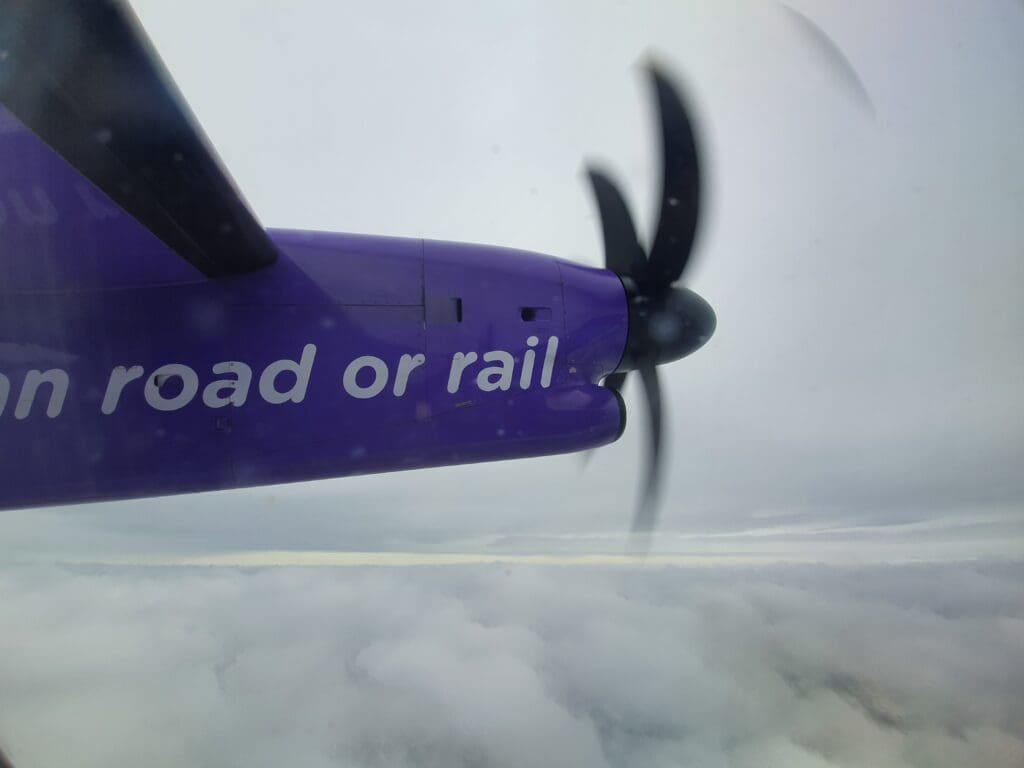
Turning my attention to the world below, thanks to the downpours across much of Britain that day, little could be seen below during the initial stages of the flight. However, a little under twenty minutes following departure, a break in the clouds revealed the town of Reading, which, was I a football fan, I would have been able to identify thanks to the city’s Madejski Stadium. After passing over the city, the two friendly cabin crew members who appeared to have great success at selling the onboard food and drink (perhaps owing to the fact that they asked every single passenger if they would like to purchase anything), reached my row.
Given Flybe’s status as a European low cost carrier, it would have been absolutely unthinkable to expect any complimentary drinks or snacks onboard the flight. Instead, those such as myself, unable to go more than sixty minutes without refreshment were left to turn to the Café Flybe menu. I found the menu to be fairly comprehensive, with all manner of drinks (soft, hot and alcoholic), snacks and breakfast options plus a small range of goods from the British Japanese restaurant brand Itsu. As was to be expected, almost everything was sold at an inflated price, with most goods coming in at around double the cost of what one would expect to pay for such items in a supermarket. The exception to this was hot drinks which were priced at £2.50 each (above McDonalds’ prices but below those you would expect to pay in a coffee shop). The three varieties of sandwiches came in at a hefty £4 a piece, however, this was still cheaper than the prices one can pay for these on the likes of EasyJet, Jet2 or Ryanair. Snack combinations softened the blow a little, but not by much, with a hot drink and a small packet of biscuits costing £3, or £3.50 for a hot drink and chocolate bar. Having already deciphered that the former £3 combination was likely the best value-for-money option, I opted for a cappuccino and shortbread as soon as the crew members reached my row. Both were promptly handed over to me and I was advised to stir the coffee well before taking a sip. Despite the coffee coming from a major brand (Kenco to be precise), this was watery and weak, however to be honest seeing as I had not expected great things from this, I was hardly disappointed.
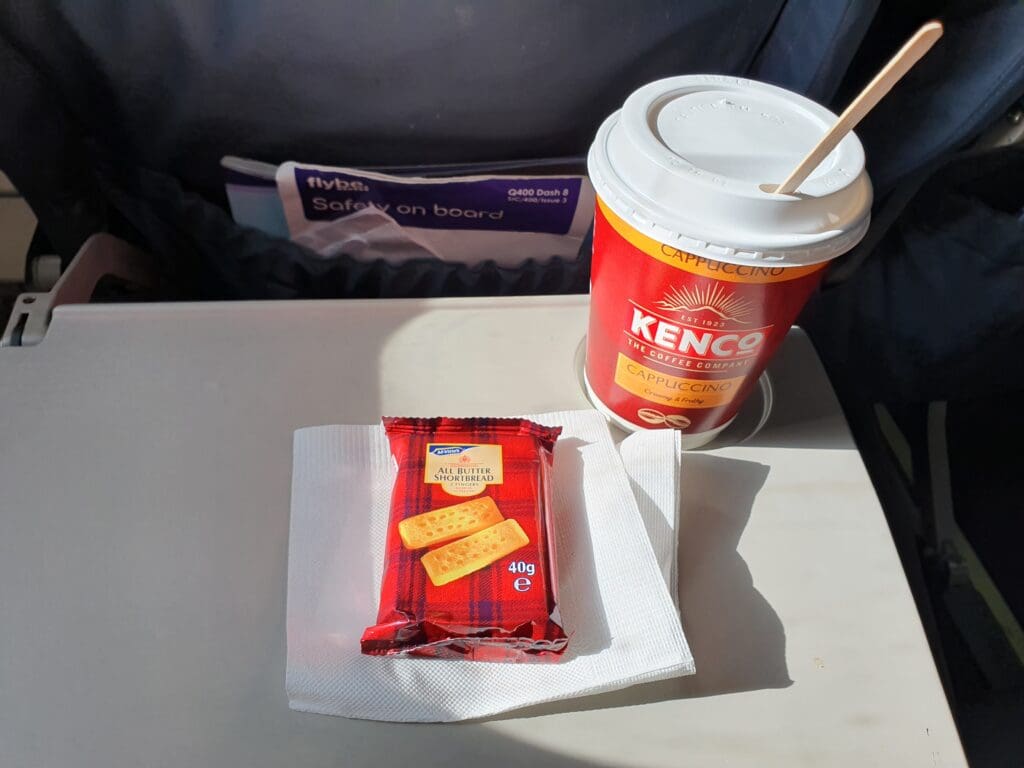
By the time the aircraft reached Britain’s South Coast, the grey clouds below had almost entirely faded away and passengers on the left were offered good views of Southampton including the city’s airport, the neighbouring Fawley Refinery (the largest oil refinery in the UK) and the entirety of the Isle of Wight before heading out for a short crossing of the Channel.
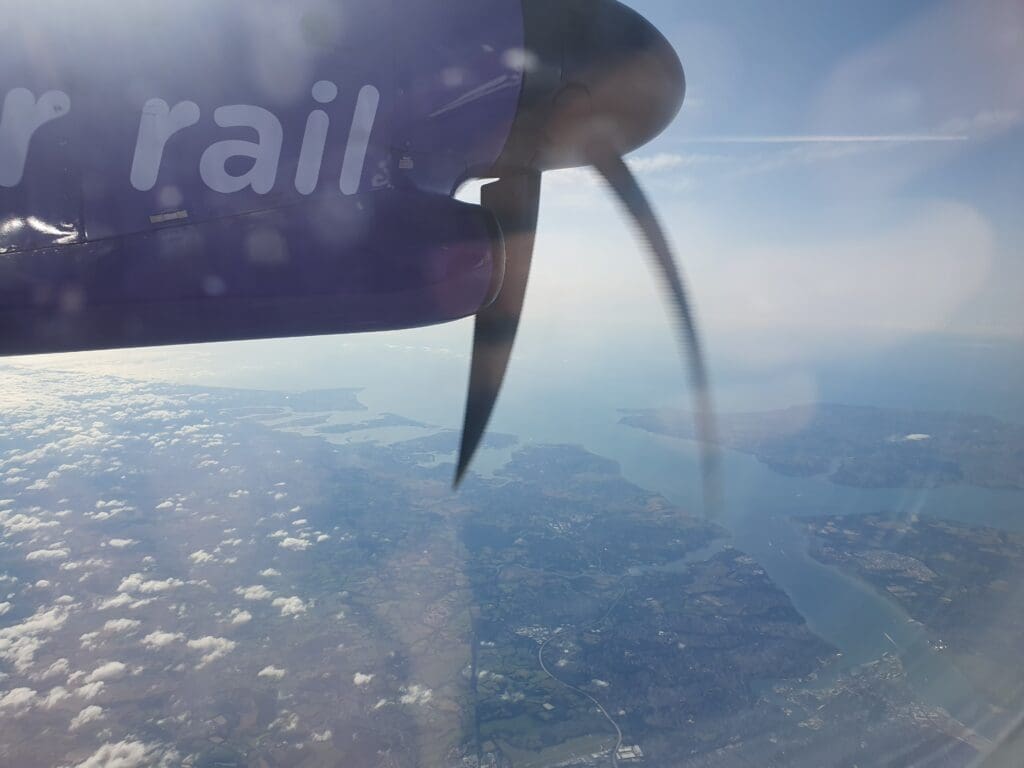
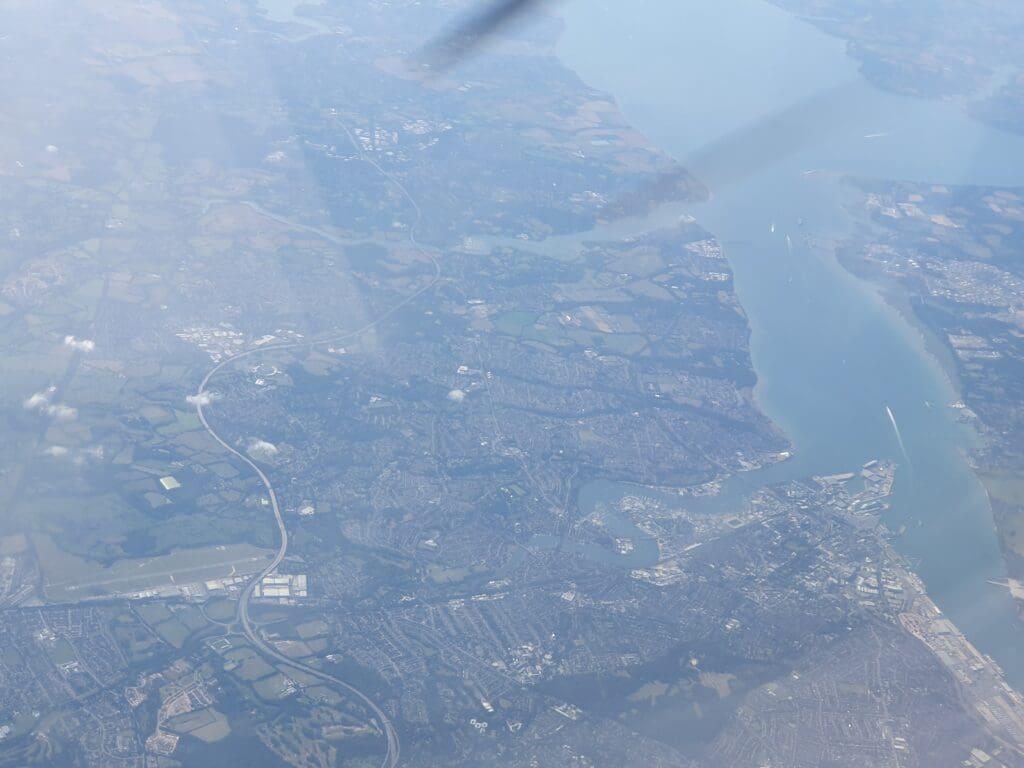
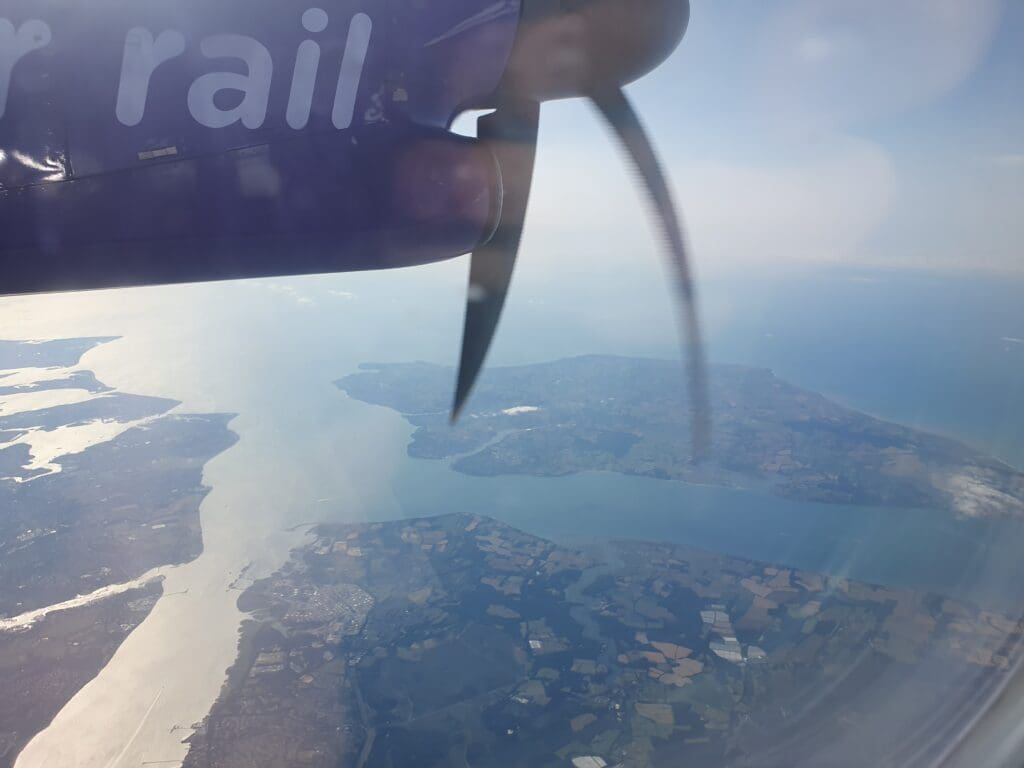
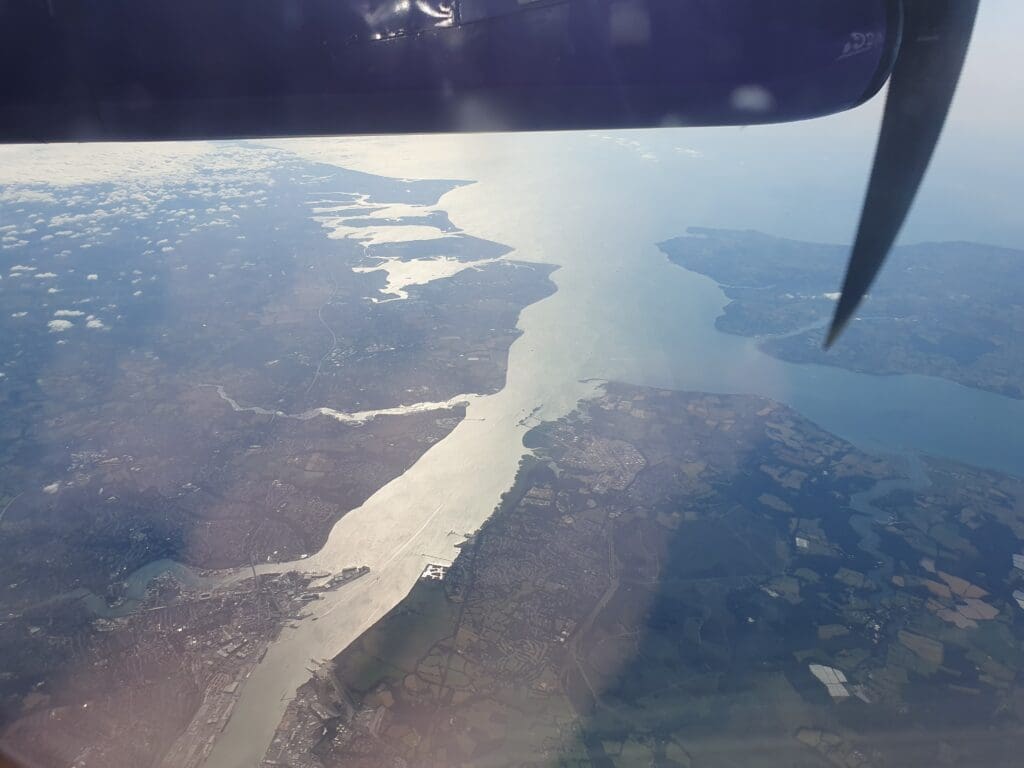
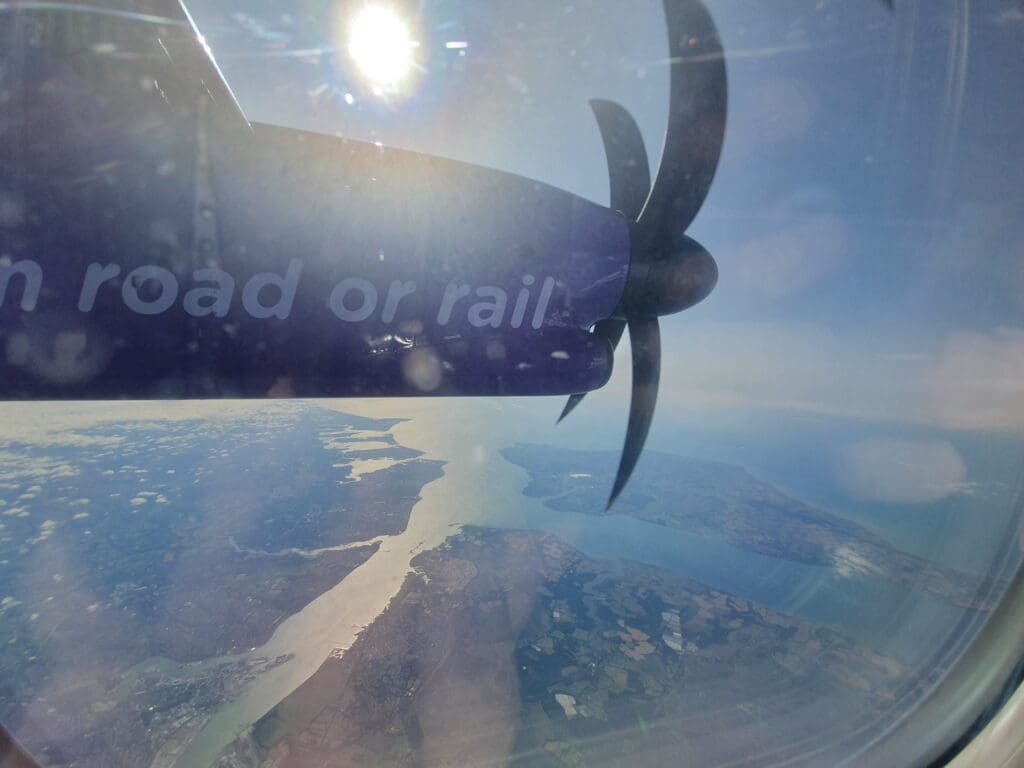
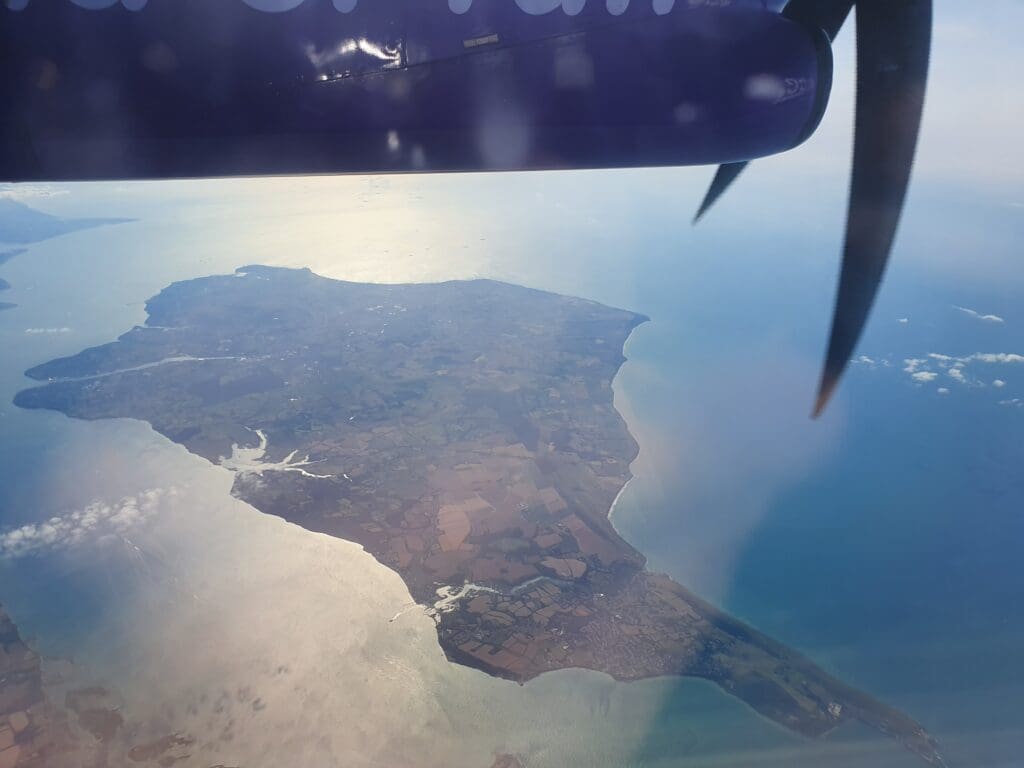
Within ten minutes, Normandy came into view which was followed by the small Channel Island of Alderney. The aircraft then flew parallel to Normandy’s yellow sandy beaches as the aircraft cruised southwards towards Brittany at an altitude of 25,000 feet. Whilst I was given a scenic view of France, those on the right-hand side of the aircraft were instead offered vistas of Guernsey and Jersey. Once past the small Chausey Islands, the aircraft made landfall to the east of St Malo and the aircraft headed over the region’s green fields before the clouds promptly moved in some way beneath the aircraft.
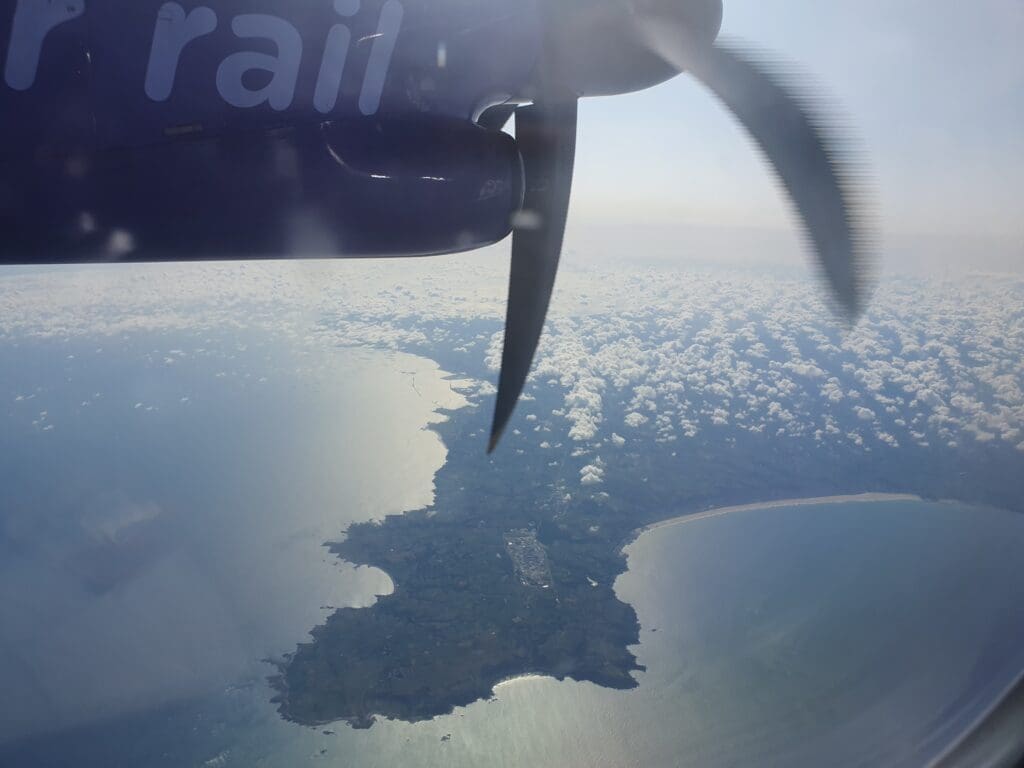
With not a great deal to see outside, I decided to head to the toilet at the front of the aircraft. Whilst I most definitely cannot blame Flybe for this, despite being of average stature, I found this to be small and cramped, seemingly more so than on many other turboprop aircraft. In addition, given the superb state of the cabin, I was a little surprised to see the toilet appeared to be somewhat battered and worn. However, this was stocked with the basics and ultimately served its purpose. Upon returning to my seat, being rather tired from my early start and minimal sleep, I took a short ten-minute nap. By the time I woke up, the clouds beneath us had cleared once again and the long River Loire came into view beneath us as the aircraft crossed over the coastal city of Nantes.
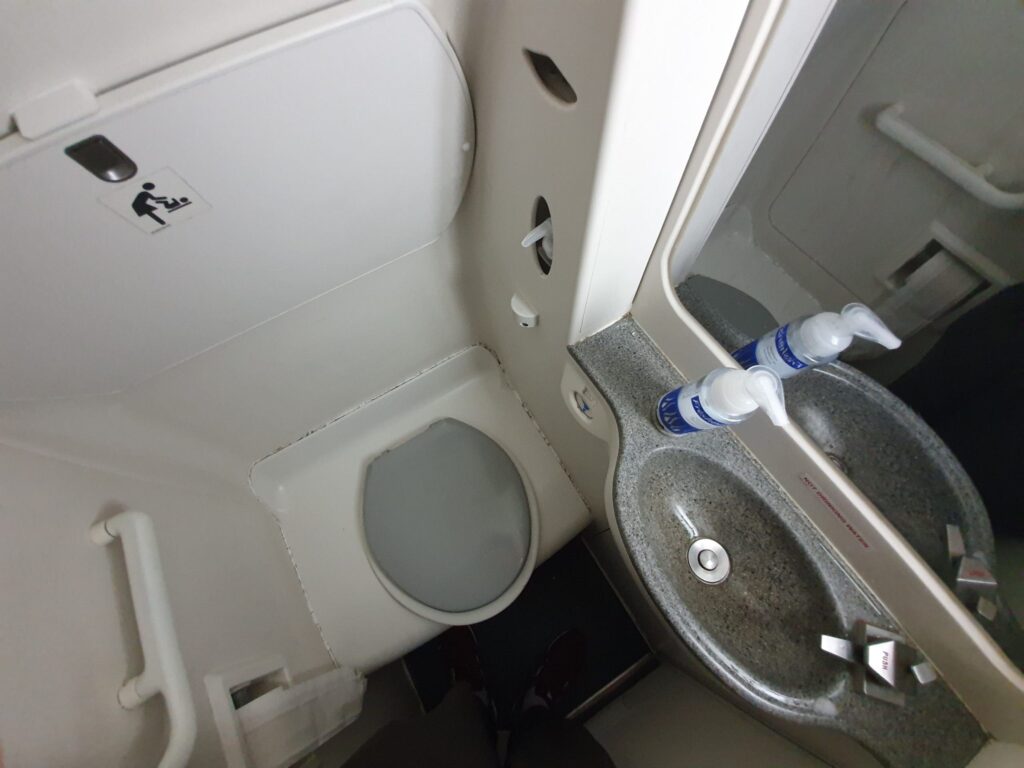
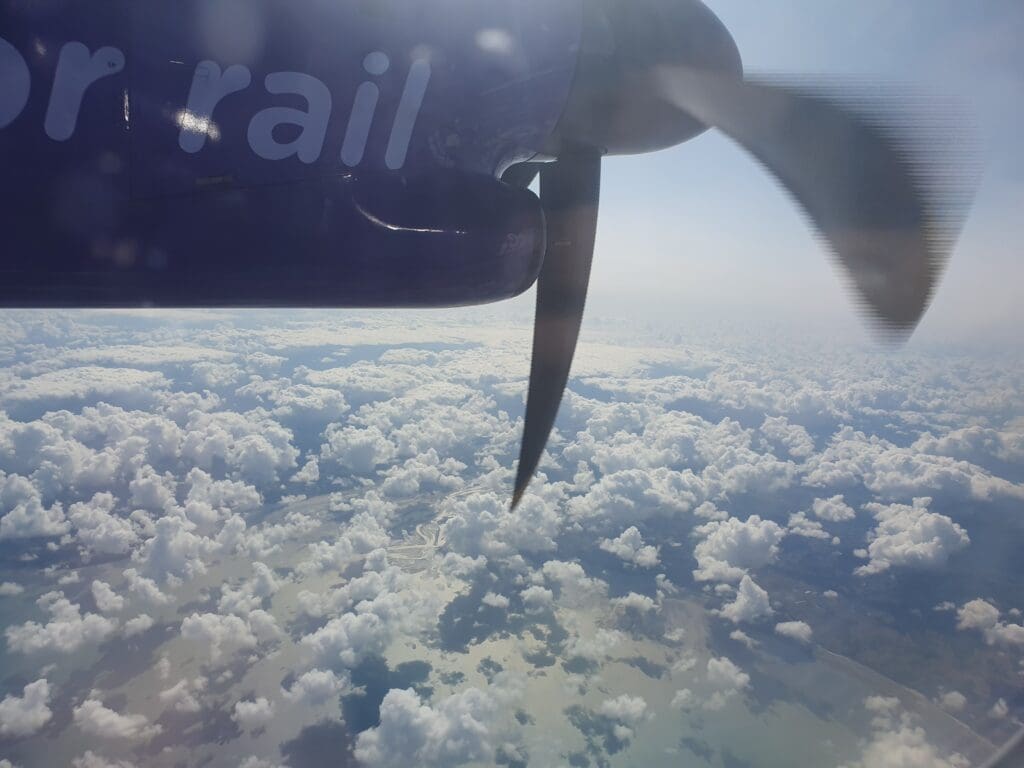
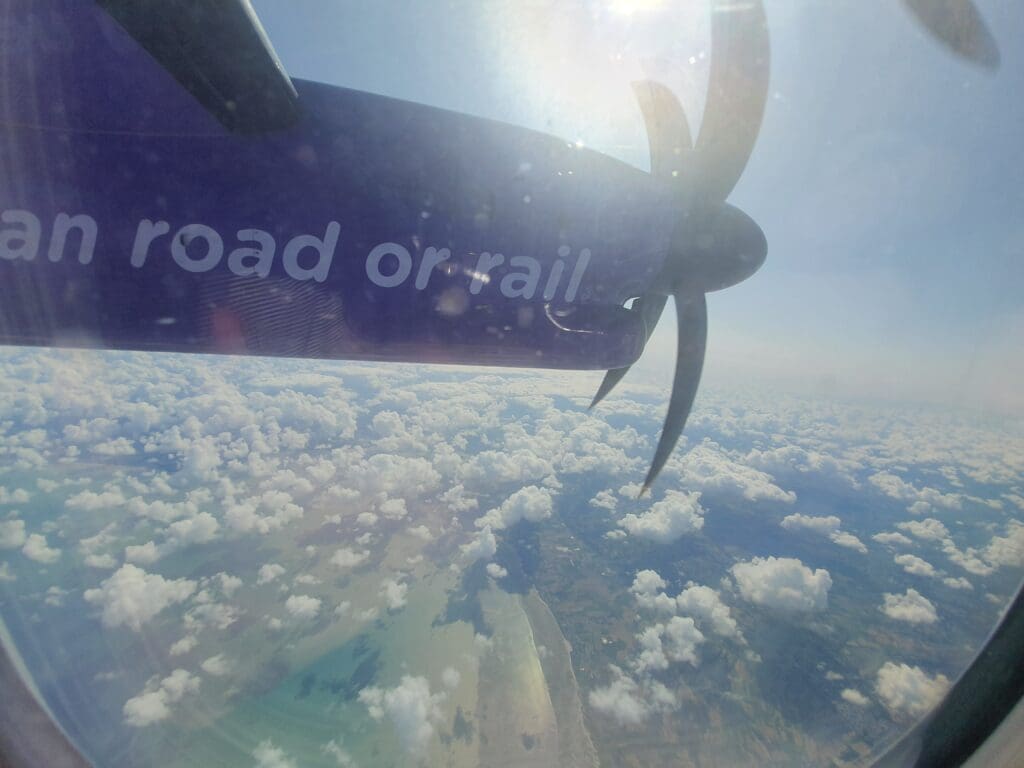
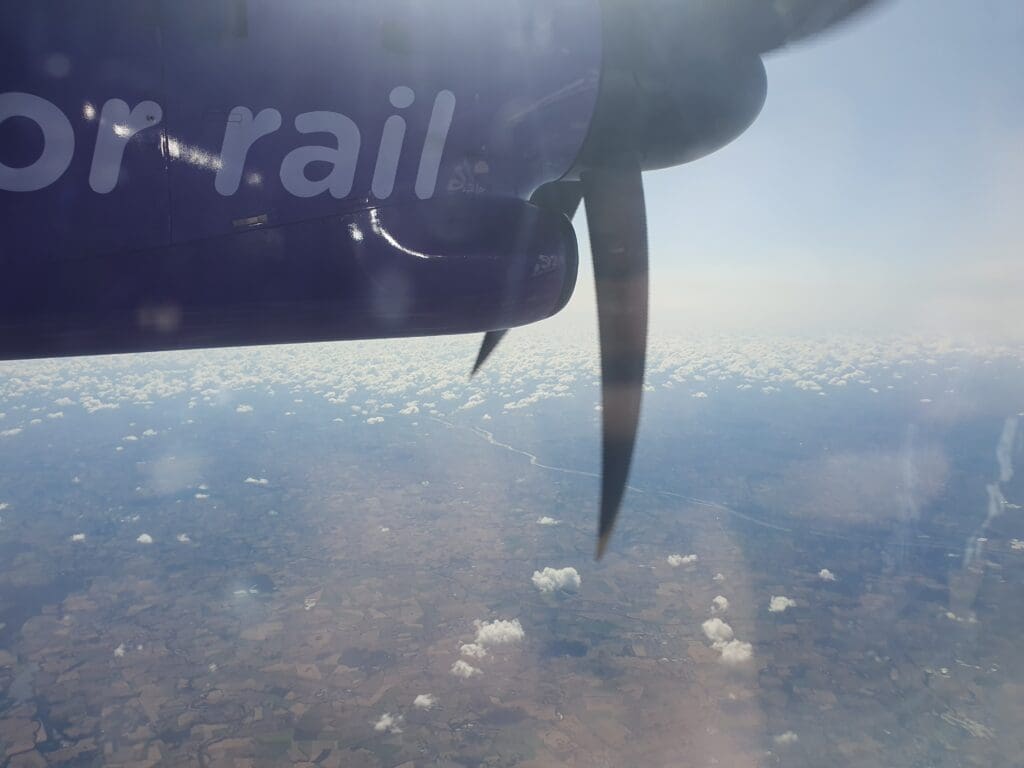
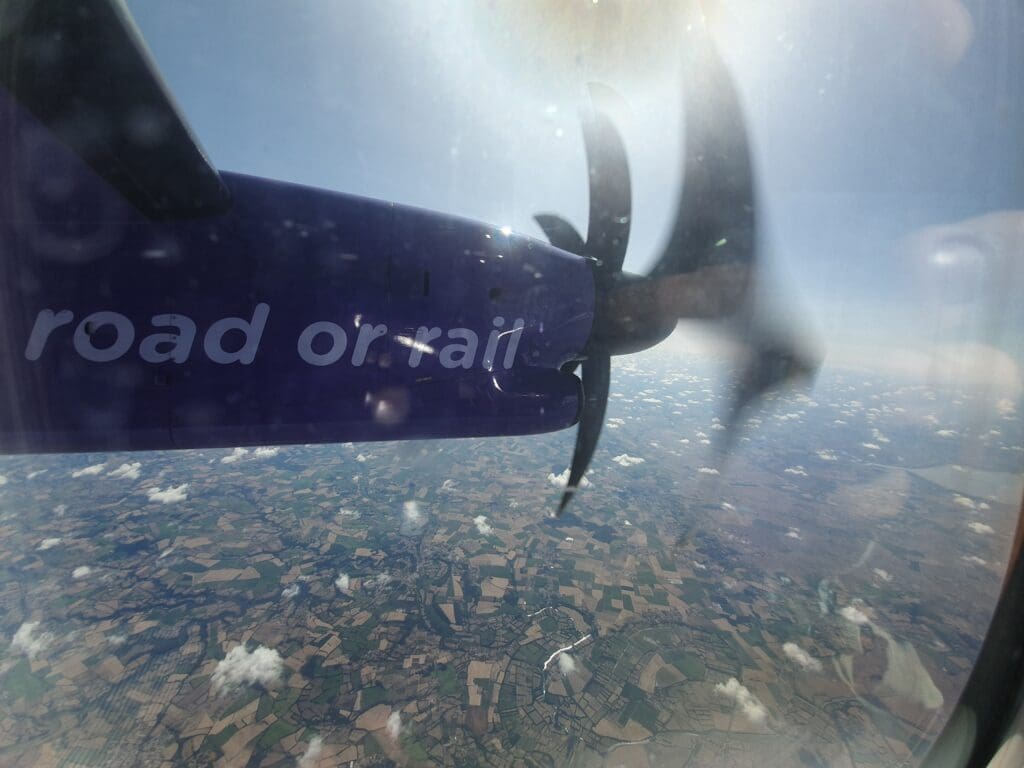
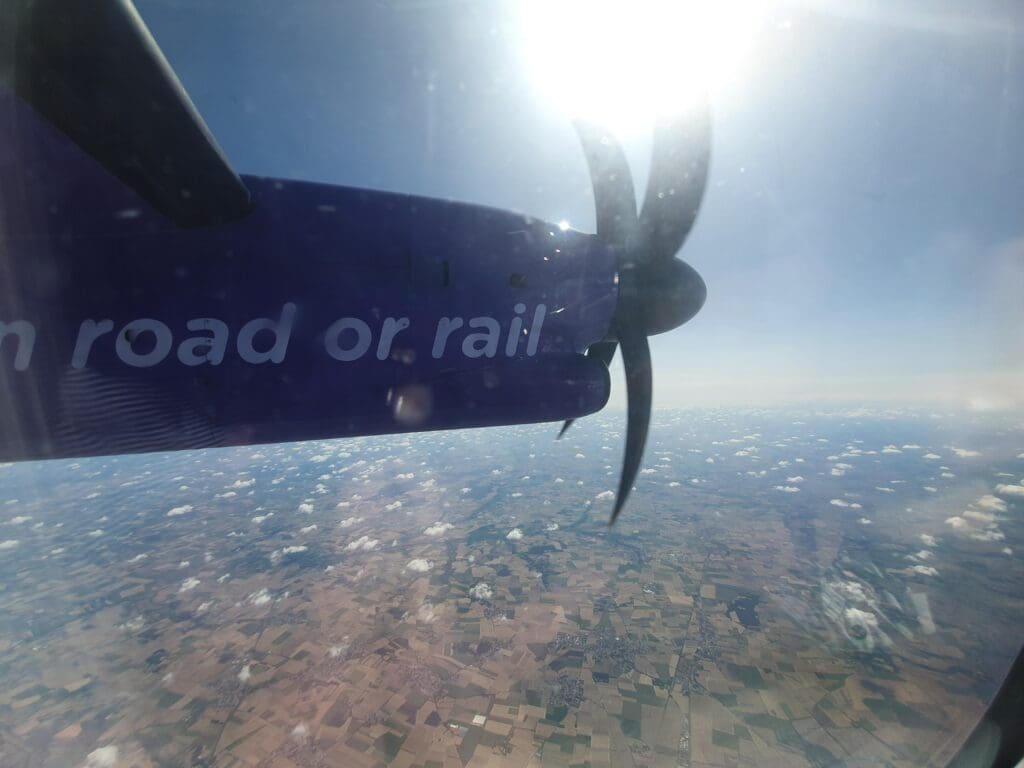
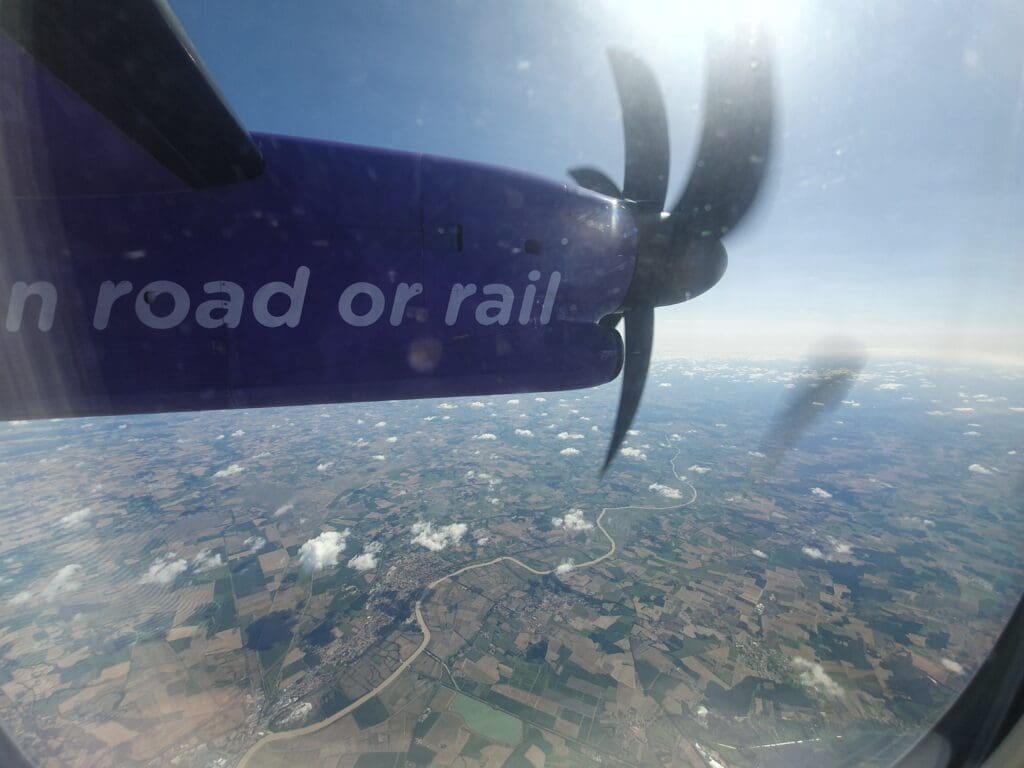
Only a minute or so after passing over Nantes, the aircraft commenced its long, slow and smooth descent as the aircraft headed down the Atlantic coast, passing directly above La Rochelle and Rochefort. Just before reaching the former city, at 1110 local time, an announcement was made informing all that the aircraft was thirty minutes away from Bordeaux and that the Café Flybe service soon be unavailable, with those passengers wanting any last minute nourishment invited to press their call button. Seeing as Flybe no longer offers any duty free service on virtually all of its routes, after conducting the BoB service, the crew spent the flight in the rear galley. Whilst this would be somewhat unacceptable on a long flight, assuming that they would have tended to passenger requests promptly, I have no qualms about their absence from the cabin given the length of the flight. At 1120, an airfield near the town of Saintes came to break the monotony of the flat rural landscape below and a short ‘cabin crew prepare the cabin for landing’ announcement was made moments later. This was followed by a more comprehensive announcement from the purser and a rubbish round was made by the two crew members in preparation for the flight’s arrival into Bordeaux.
For much of this stage of the flight, the aircraft flew parallel with the Route des Estuaires which runs from Belgium to Spain, passing along the French coastline all the way from Dunkerque to Bayonne. Not too long after, the Dash 8 continued its gentle float downwards over the wide Gironde after which sitting on the left-hand side of the aircraft, I was offered fantastic views of the centre of Bordeaux.
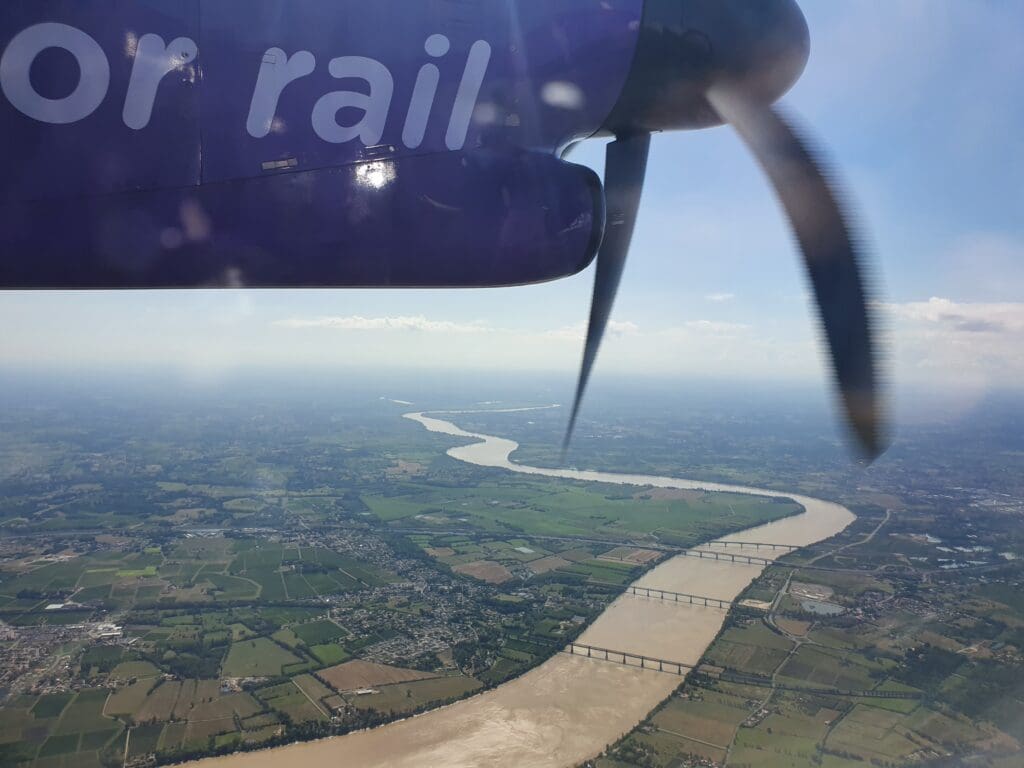
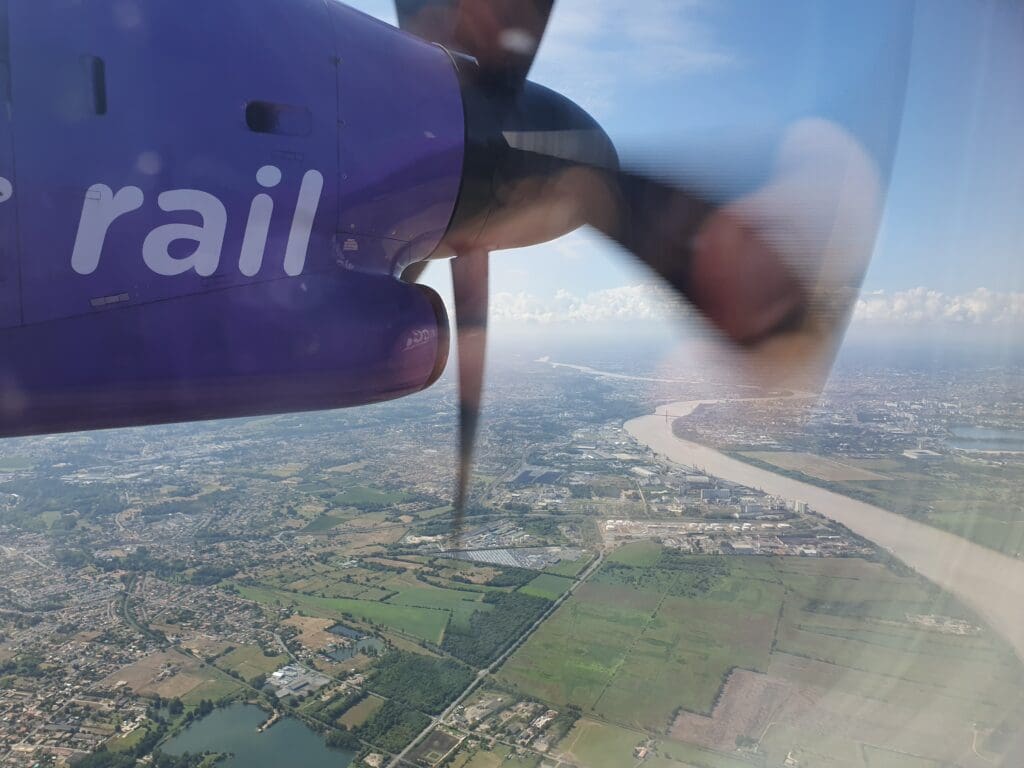
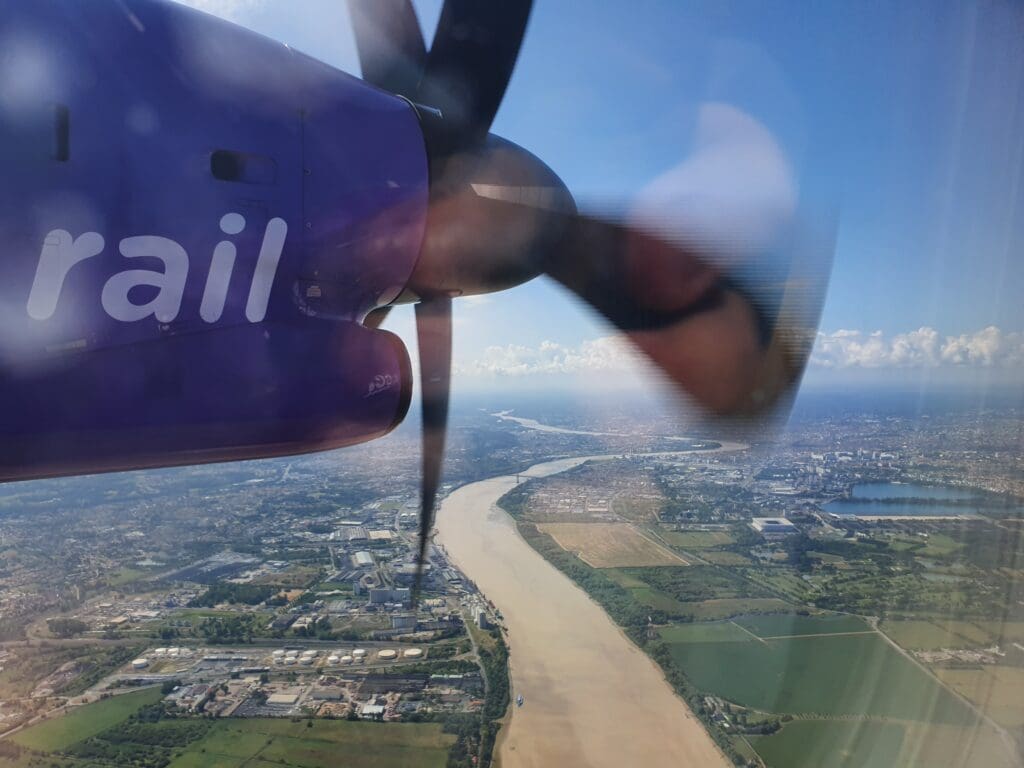
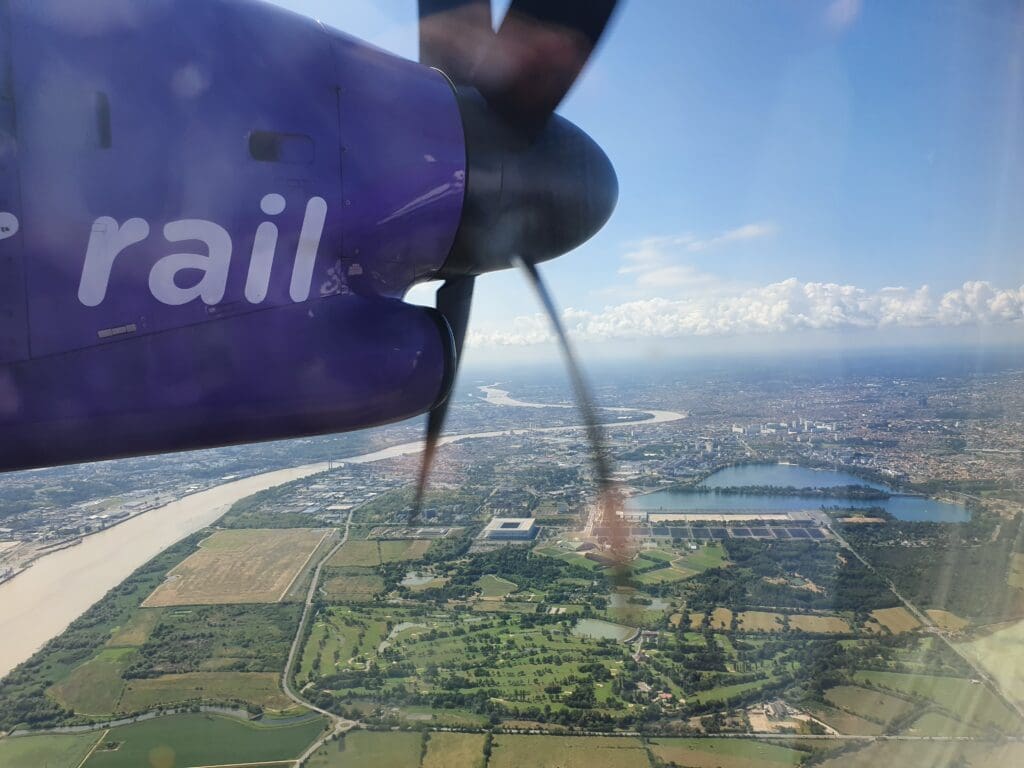
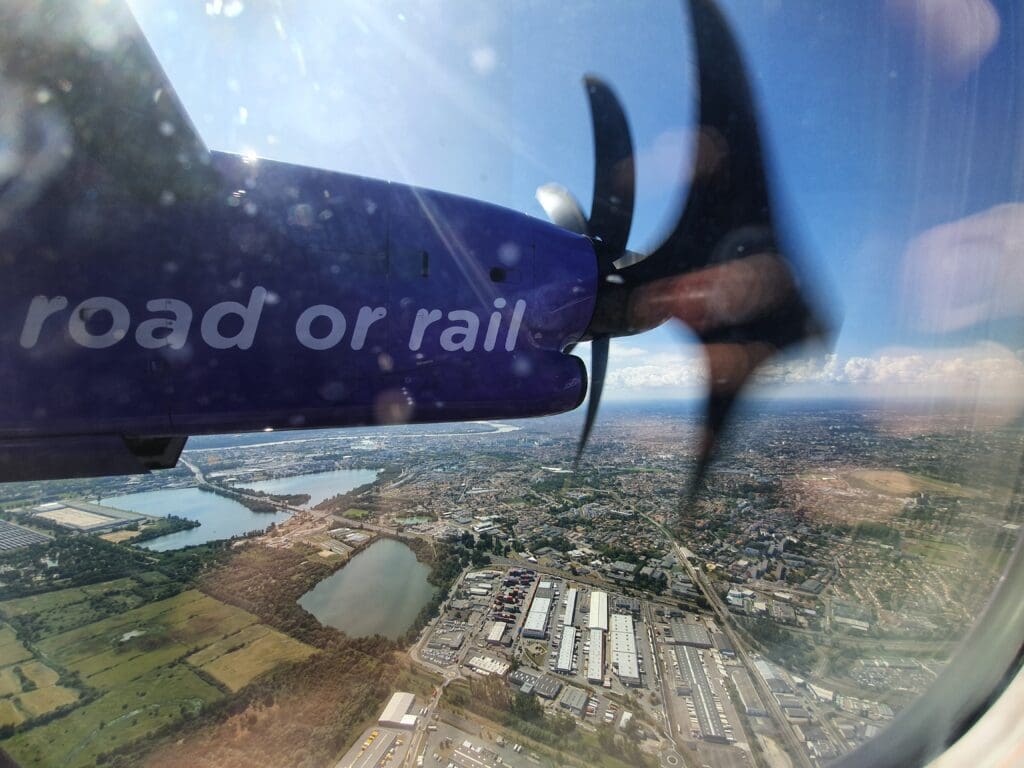
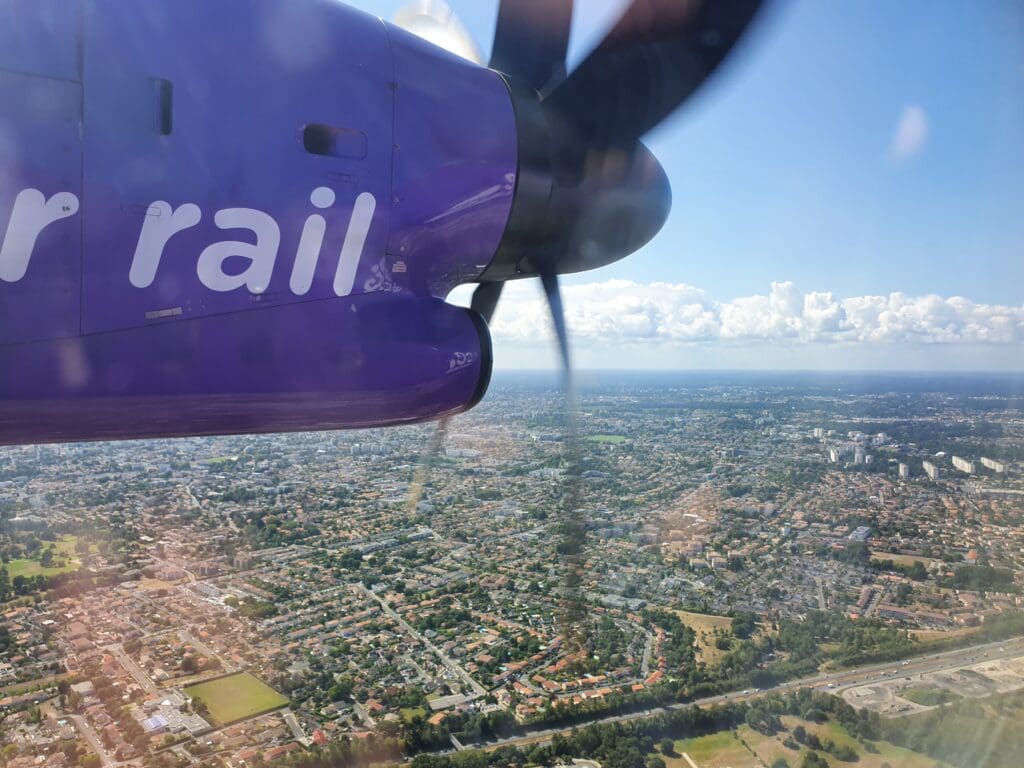
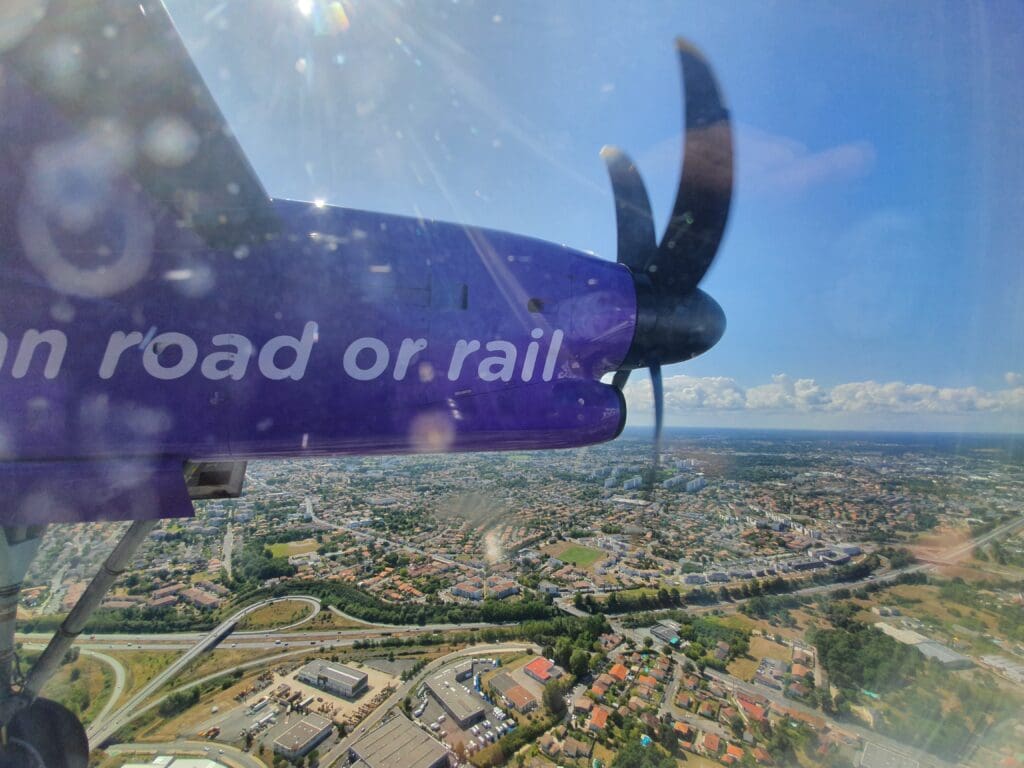
After flying over a mix of industrial and residential areas, at 1134 the aircraft gently floated over the threshold of Runway 23 before returning to the ground with an almighty thump. Heavy braking followed the touchdown, as the aircraft decelerated past the main terminal before soon taxying off the runway whilst the purser performed a short welcome speech. After leaving the runway the aircraft’s left hand engine spooled down resulting in a somewhat quiet taxi to the terminal. Within minutes, the aircraft cautiously pulled into a stand next to a Turkish Airlines Boeing 737-800 as well as a luxurious Bombardier Global 6000.
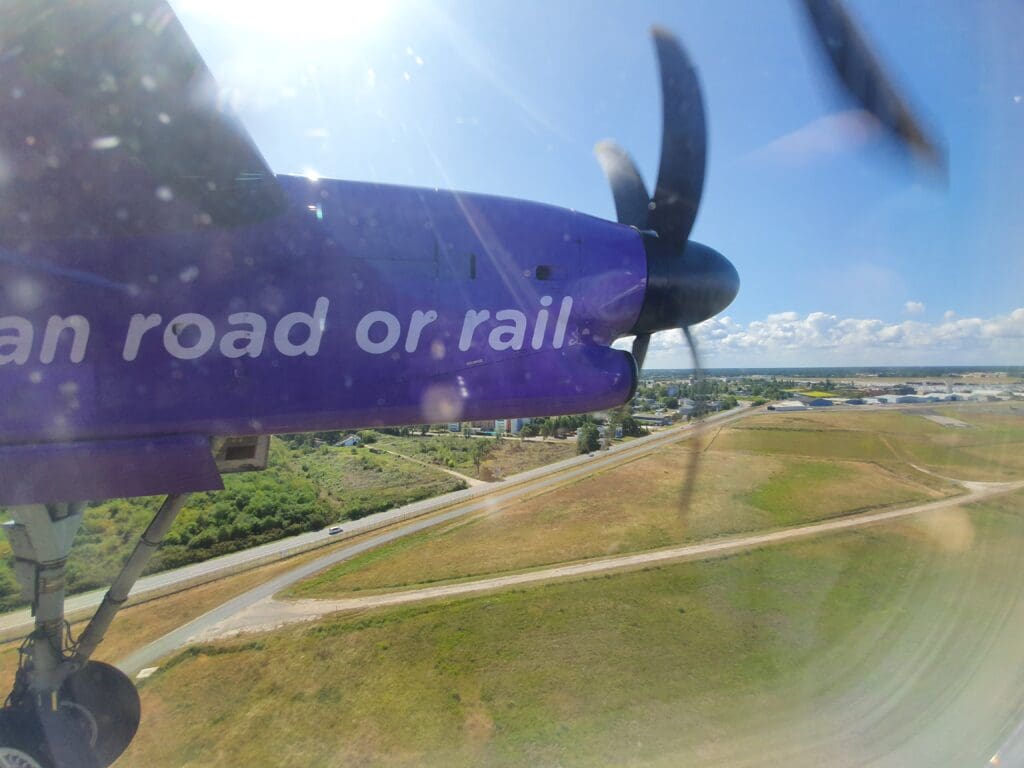
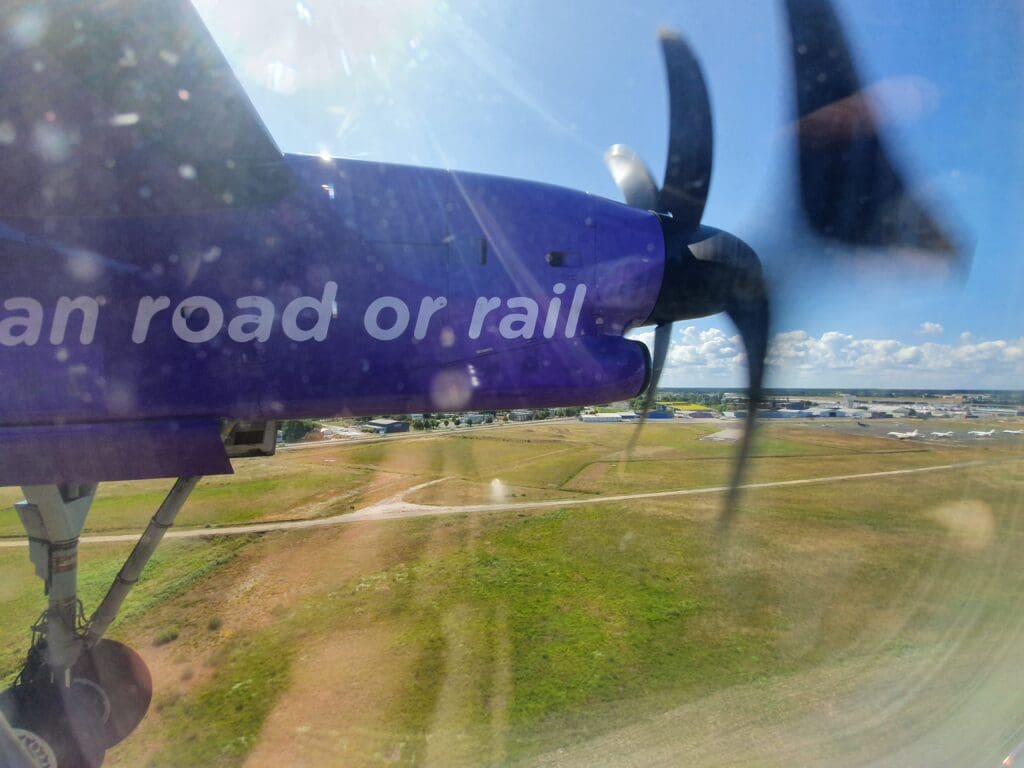

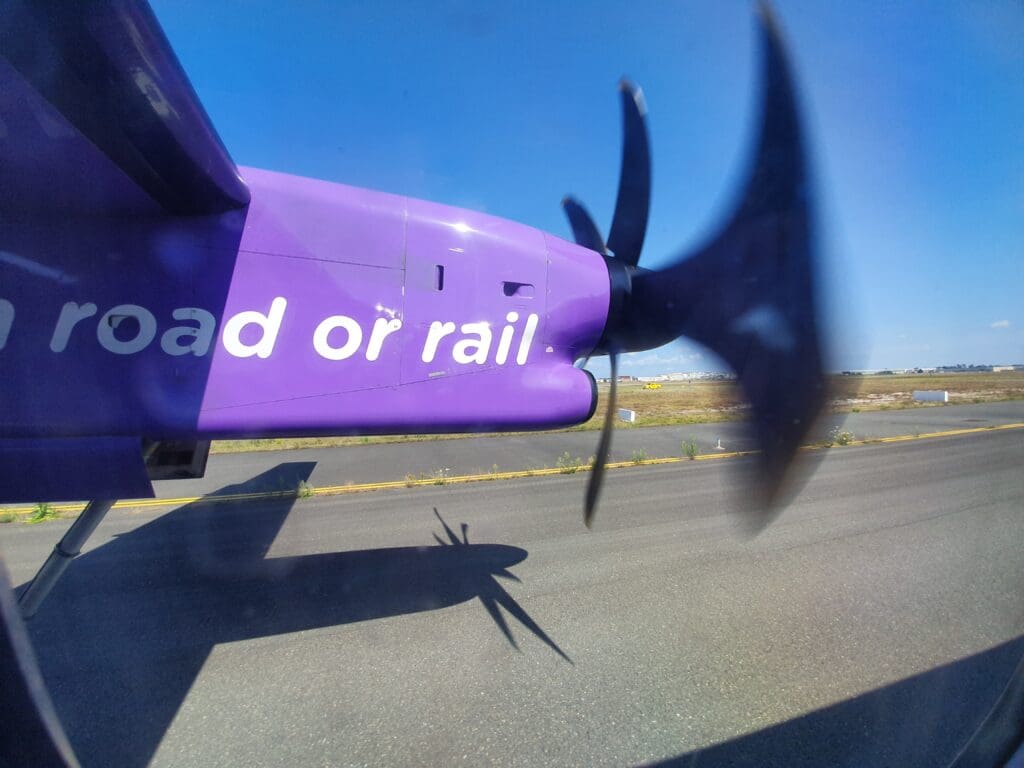
Only five minutes after touching down, the cabin door opened and passengers began to disembark into the summer heat of Southwest France. Thanks to most passengers’ lack of any extremely large hand luggage, disembarkation was a rather quick process and within a couple of minutes I found myself thanking the Purser before heading down the aircraft’s steps and onto the ramp. From there, it was a quick walk to the terminal’s small immigration hall. Unlike Paris’ two major airports, Bordeaux Merignac lacks e-gates and instead, all passengers had little option other than to queue up to one of three booths. Seeing as I ended up near the front of the queue, I was able to pass through and enter France within approximately three minutes of stepping into the immigration hall after which I strolled through the baggage claim area and exited into the landside portion of the terminal.
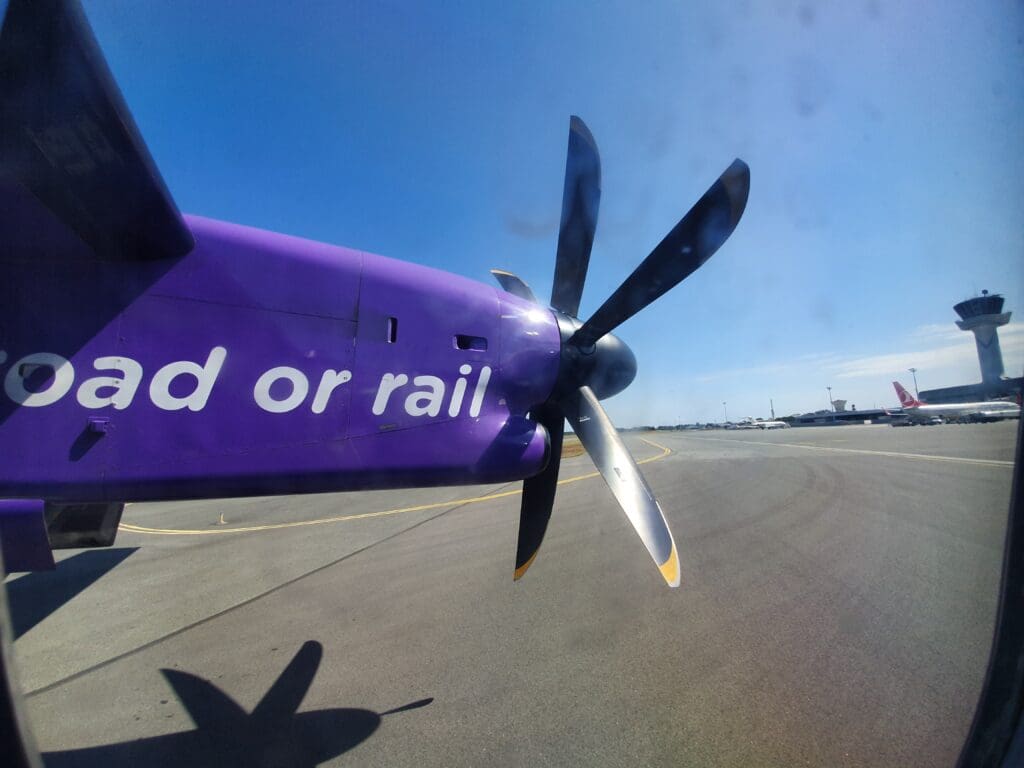
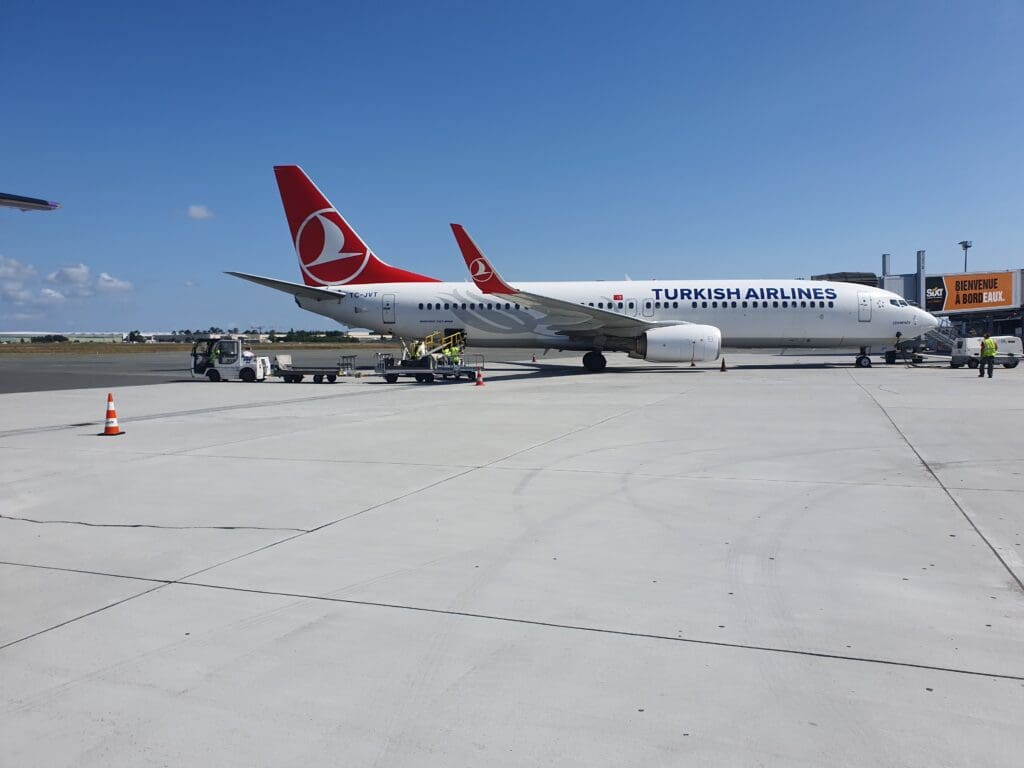
Summary
Having had mixed experiences with Flybe in the past, I was very pleased with my flight with the airline that morning. The aircraft was clean and in good condition, the crew were friendly and the flight arrived on time ensuring I was left with nothing to complain about.

